Paul van Yperen's Blog, page 51
May 8, 2024
Le grand bleu (1988)
Le grand bleu/The Big Blue (Luc Besson, 1988) is a beautiful and serene French film. Jean-Marc Barr plays French diver Jacques Mayol, alongside Rosanna Arquette and Jean Reno. Le grand bleu became the most financially successful film in France in the 1980s.
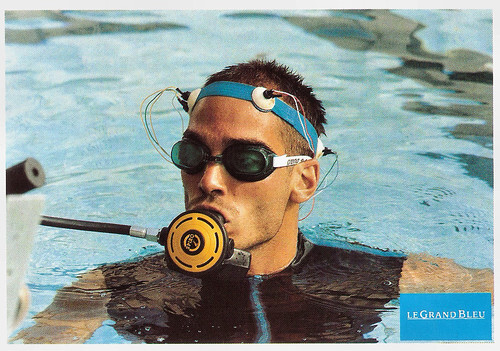
French postcard by Ciné Passion, no. GB 3. Photo: Jean-Marc Barr in Le Grand Bleu (Luc Besson, 1988).
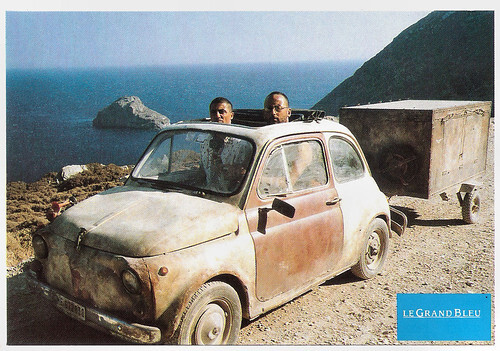
French postcard by Ciné Passion, no. GB 5. Photo: Marc Duret and Jean Reno (right) in Le Grand Bleu (Luc Besson, 1988).
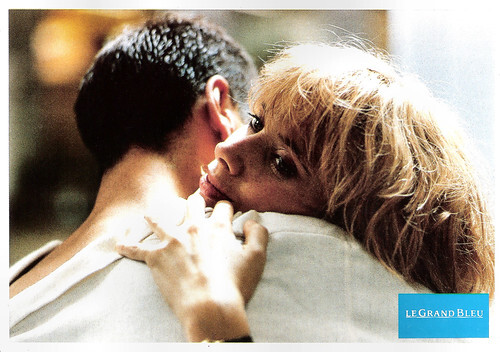
French postcard by Ciné Passion, no. GB 6. Photo: Jean-Marc Barr and Rosanna Arquette in Le Grand Bleu (Luc Besson, 1988).

French postcard by Ciné Passion, no. GB 7. Photo: publicity still for Le Grand Bleu (Luc Besson, 1988) with Jean-Marc Barr .
Eternal heaven
Le grand bleu/The Big Blue (1988) is a fictionalised and dramatised story of the friendship and sporting rivalry between two leading contemporary champion free divers in the 20th century: Jacques Mayol (played by Jean-Marc Barr ) and Enzo Maiorca (renamed to Enzo Molinari and played by Jean Reno ), and Mayol's fictionalised relationship with his girlfriend Johana Baker (played by Rosanna Arquette).
The film covers their childhood in 1960s Greece to their deaths in a 1980s Sicilian diving competition. Jacques and Enzo are fascinated by the sea but for different reasons. If Enzo devotes all his energies to diving to access success and glory, the sea is more than this for Jacques.
For Jacques, the ocean is a place of athletic competition, an ideal place for rest and entertainment where dolphins are his real and sole friends, and finally, it's his eternal heaven. He was born with it, he swears by it and the sea will lead him to his death.
Mayol's and Maiorca's stories were heavily adapted for cinema. In real life, Mayol lived from 1927 to 2001 and Maiorca retired from diving to politics in the 1980s. Both set no-limits category deep diving records below 100 metres.
Mayol was involved in scientific research into human aquatic potential. However, neither reached 400 feet (122 metres) as portrayed in the film, and they were not direct competitors. Mayol himself was a screenwriter for the film.
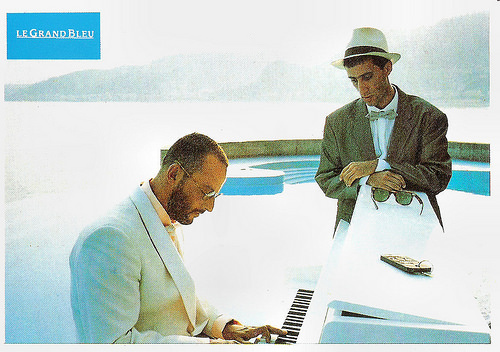
French postcard by Ciné Passion, no. GB 1. Photo: publicity still for Le grand bleu (Luc Besson, 1988) with Jean Reno and Sergio Castellitto.
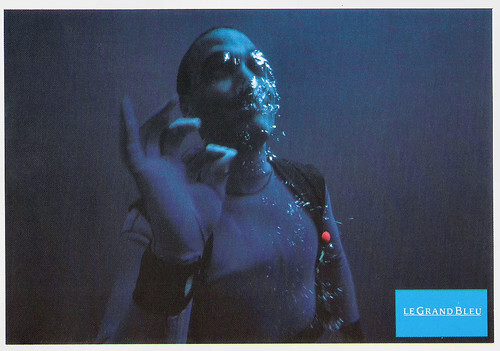
French postcard by Ciné Passion, no. GB 2. Photo: Jean-Marc Barr in Le Grand Bleu (Luc Besson, 1988).
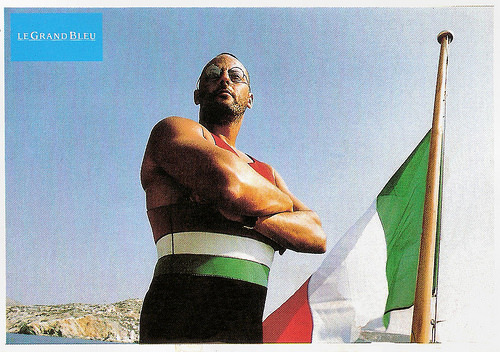
French postcard by Ciné Passion, no. GB 4. Photo: publicity still for Le grand bleu (Luc Besson, 1988) with Jean Reno .
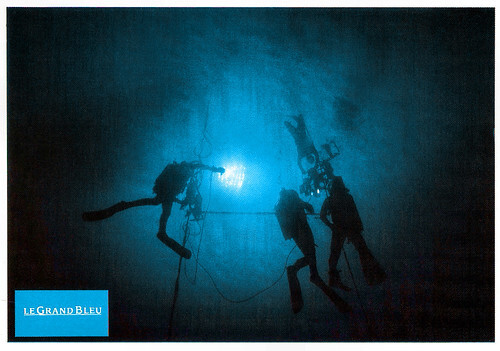
French postcard by Ciné Passion, no. GB 8. Photo: publicity still for Le Grand Bleu (Luc Besson, 1988).
Le look
Luc Besson was initially unsure of whom to cast in the main role of Jacques Mayol. He initially offered the role to Christopher Lambert and Mickey Rourke and even considered himself for the role until someone suggested Jean-Marc Barr . Besson has a cameo appearance as one of the divers in the film.
Le grand bleu/The Big Blue meant Besson's international breakthrough. It's a key film which divided the French public between those who saw the film only as a tedious documentary about the ocean and those who acclaimed this as passionate filmmaking.
The film is one of the finest examples of the 'Cinéma du look' visual style of the 1980s. Besson, Jean-Jacques Beineix and Leos Carax are the main directors of 'Le Look'. Their films had a slick, gorgeous visual style and a focus on young, alienated characters.
Le grand bleu/The Big Blue is a cult classic in the diving fraternity. It was nominated for several César Awards and won the César Award for Best Music Written for a Film (Eric Serra) and Best Sound in 1989. The film also won France's National Academy of Cinema's Academy Award in 1989. Besson's film also became one of France's biggest box office hits. It sold 9,193,873 tickets in France alone and played in French theatres for a year. While popular in Europe, an adaptation for the US release was a commercial failure in that country.
DB Dumonteil at IMDb : "Le Grand bleu also ranks among the movies that you must watch rather than telling it. Of course, there isn't almost any plot, dialogues are short and rare but the pictures are gorgeous enough to create an entrancing climate supported by Eric Serra's mesmerising music.
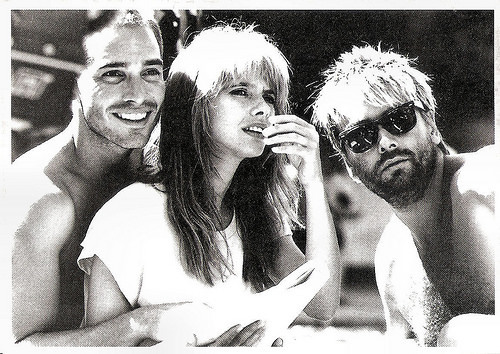
French postcard by Especially for you, Ref. 30. Photo: publicity still for Le grand bleu (Luc Besson, 1988). Jean-Marc Barr , Rosanna Arquette and Luc Besson at the set.
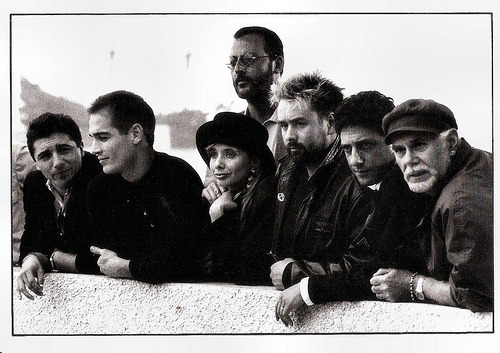
French postcard by News Productions, Beaulmes, no 56063. Photo: Eric Coiffier. Director and cast of Le Grand bleu (Luc Besson, 1988) at the Festival de Cannes, 1988. In the front row from left to right: Marc Duret, Jean-Marc Barr , Rosanna Arquette, Luc Besson, Sergio Castellitto and Andréas Voutsinas. In the back: Jean Reno.
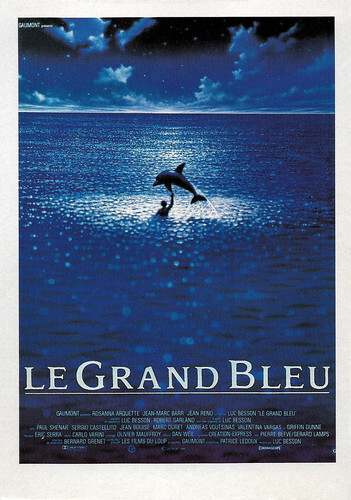
French postcard by Editions F. Nugeron, no. E 489. Image: Gaumont. French poster by Malinowski for Le Grand Bleu (Luc Besson, 1988).
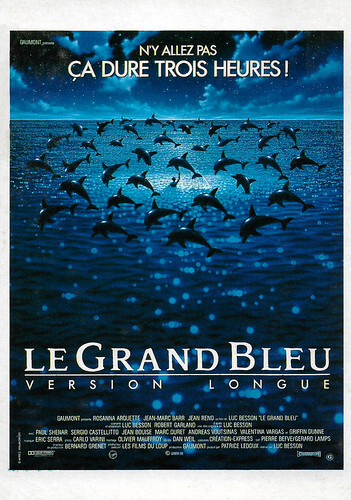
French postcard by Editions Ramsay / Editions F. Nugeron, no. 49. Image: Gaumont. French poster by Malinowski for the long version of Le Grand Bleu (Luc Besson, 1988).
Sources: DB Dumonteil (IMDb), Wikipedia and IMDb.

French postcard by Ciné Passion, no. GB 3. Photo: Jean-Marc Barr in Le Grand Bleu (Luc Besson, 1988).

French postcard by Ciné Passion, no. GB 5. Photo: Marc Duret and Jean Reno (right) in Le Grand Bleu (Luc Besson, 1988).

French postcard by Ciné Passion, no. GB 6. Photo: Jean-Marc Barr and Rosanna Arquette in Le Grand Bleu (Luc Besson, 1988).

French postcard by Ciné Passion, no. GB 7. Photo: publicity still for Le Grand Bleu (Luc Besson, 1988) with Jean-Marc Barr .
Eternal heaven
Le grand bleu/The Big Blue (1988) is a fictionalised and dramatised story of the friendship and sporting rivalry between two leading contemporary champion free divers in the 20th century: Jacques Mayol (played by Jean-Marc Barr ) and Enzo Maiorca (renamed to Enzo Molinari and played by Jean Reno ), and Mayol's fictionalised relationship with his girlfriend Johana Baker (played by Rosanna Arquette).
The film covers their childhood in 1960s Greece to their deaths in a 1980s Sicilian diving competition. Jacques and Enzo are fascinated by the sea but for different reasons. If Enzo devotes all his energies to diving to access success and glory, the sea is more than this for Jacques.
For Jacques, the ocean is a place of athletic competition, an ideal place for rest and entertainment where dolphins are his real and sole friends, and finally, it's his eternal heaven. He was born with it, he swears by it and the sea will lead him to his death.
Mayol's and Maiorca's stories were heavily adapted for cinema. In real life, Mayol lived from 1927 to 2001 and Maiorca retired from diving to politics in the 1980s. Both set no-limits category deep diving records below 100 metres.
Mayol was involved in scientific research into human aquatic potential. However, neither reached 400 feet (122 metres) as portrayed in the film, and they were not direct competitors. Mayol himself was a screenwriter for the film.

French postcard by Ciné Passion, no. GB 1. Photo: publicity still for Le grand bleu (Luc Besson, 1988) with Jean Reno and Sergio Castellitto.

French postcard by Ciné Passion, no. GB 2. Photo: Jean-Marc Barr in Le Grand Bleu (Luc Besson, 1988).

French postcard by Ciné Passion, no. GB 4. Photo: publicity still for Le grand bleu (Luc Besson, 1988) with Jean Reno .

French postcard by Ciné Passion, no. GB 8. Photo: publicity still for Le Grand Bleu (Luc Besson, 1988).
Le look
Luc Besson was initially unsure of whom to cast in the main role of Jacques Mayol. He initially offered the role to Christopher Lambert and Mickey Rourke and even considered himself for the role until someone suggested Jean-Marc Barr . Besson has a cameo appearance as one of the divers in the film.
Le grand bleu/The Big Blue meant Besson's international breakthrough. It's a key film which divided the French public between those who saw the film only as a tedious documentary about the ocean and those who acclaimed this as passionate filmmaking.
The film is one of the finest examples of the 'Cinéma du look' visual style of the 1980s. Besson, Jean-Jacques Beineix and Leos Carax are the main directors of 'Le Look'. Their films had a slick, gorgeous visual style and a focus on young, alienated characters.
Le grand bleu/The Big Blue is a cult classic in the diving fraternity. It was nominated for several César Awards and won the César Award for Best Music Written for a Film (Eric Serra) and Best Sound in 1989. The film also won France's National Academy of Cinema's Academy Award in 1989. Besson's film also became one of France's biggest box office hits. It sold 9,193,873 tickets in France alone and played in French theatres for a year. While popular in Europe, an adaptation for the US release was a commercial failure in that country.
DB Dumonteil at IMDb : "Le Grand bleu also ranks among the movies that you must watch rather than telling it. Of course, there isn't almost any plot, dialogues are short and rare but the pictures are gorgeous enough to create an entrancing climate supported by Eric Serra's mesmerising music.

French postcard by Especially for you, Ref. 30. Photo: publicity still for Le grand bleu (Luc Besson, 1988). Jean-Marc Barr , Rosanna Arquette and Luc Besson at the set.

French postcard by News Productions, Beaulmes, no 56063. Photo: Eric Coiffier. Director and cast of Le Grand bleu (Luc Besson, 1988) at the Festival de Cannes, 1988. In the front row from left to right: Marc Duret, Jean-Marc Barr , Rosanna Arquette, Luc Besson, Sergio Castellitto and Andréas Voutsinas. In the back: Jean Reno.

French postcard by Editions F. Nugeron, no. E 489. Image: Gaumont. French poster by Malinowski for Le Grand Bleu (Luc Besson, 1988).

French postcard by Editions Ramsay / Editions F. Nugeron, no. 49. Image: Gaumont. French poster by Malinowski for the long version of Le Grand Bleu (Luc Besson, 1988).
Sources: DB Dumonteil (IMDb), Wikipedia and IMDb.
Published on May 08, 2024 22:00
May 6, 2024
Xavier Cugat
Spanish-American bandleader Xavier Cugat (1900-1990) was known for his musical genius and glitzy persona as the king of the posh nightclub scene with his signature tuxedo, ear-to-ear smile, pencil-thin moustache and chihuahua. He spent his youth in Havana, Cuba and was a trained violinist and arranger. He set the standard for Latin dance music for the Hollywood film industry from the 1930s onwards. 'The Rumbia King' performed in thirteen MGM musicals, weekly radio broadcasts and a sixteen-year engagement at the Waldorf Astoria Hotel in New York. With his bombshell wives like Abbe Lane and such iconic performers as Desi Arnaz and Tito Puente, he was one of the greatest promoters of the Latin-American style and helped to pave the way for the artists who followed him.
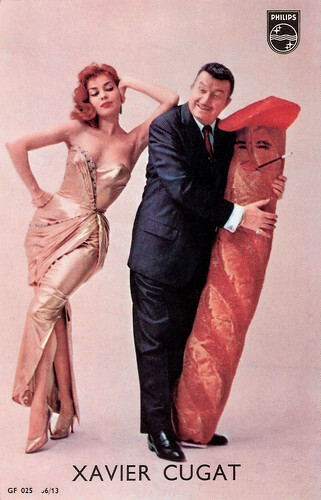
Promotion card by Philips, no. GF 025 66/13.
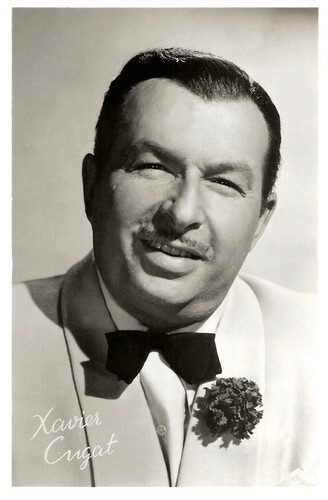
Dutch postcard. Photo: M.G.M.
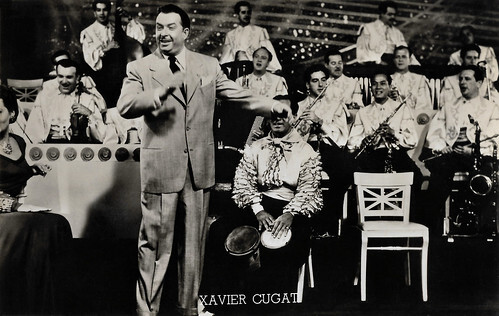
Vintage postcard, no. 1151.
The Rumba King at the fashionable Coconut Grove
Xavier Cugat was born Francisco de Asis Javier Cugat Migall de Bru y Deulofeu in 1900 in Girona, Catalonia, Spain. Cugat was born just a few minutes after midnight in the last year of the 19th century. This was considered so remarkable in his home country of Spain that his father, who was a political prisoner at the time, was pardoned and his brothers were exempted from military service. His family moved to Cuba when he was five (or three - sources differ). One of his neighbours was a violin maker who crafted a miniature version of the instrument that would become Cugat's ticket to fame. In Havana, he was trained as a classical violinist and played in cafés. He went on to work at Le Payret cinema, where he provided background music for the silent films shown there. On the recommendation of his violin teacher and after passing an audition, he was hired by the director of the Havana Symphony Orchestra, where he became the first violinist at the age of 12.
In 1915, his family migrated to New York. Like his brother, Francis Cugat (1893-1981), the artist of the famous book cover of 'The Great Gatsby' (1925), he became a graphic designer, more specifically a cartoonist. The Catalan mezzo-soprano Maria Gay introduced the young Xavier to prestigious musicians such as Pau Casals or Enric Granados. Through hard work, Cugat progressed. He met Enrico Caruso, befriended him and accompanied him on his tour of the United States. Caruso got the young man to study with the artistic director of the prestigious Carnegie Hall. Thanks to his contacts in the music world, he could perform at Carnegie Hall, where he met with only moderate success.
At the conservatory, he met Rita Montaner, who studied singing there and they married in 1918 In 1920, the young couple divorced. His family returned to Catalonia, enabling 20-year-old Cugat to study in Germany. In 1924, he returned to the United States. Once again, he appeared at Carnegie Hall. This time the audience gave him a standing ovation, but he still failed to win over the critics. Cugat felt deeply offended. In New York, he met up again with his ex Rita Montaner, and he helped her prepare for Cuban and Antillean music shows. When discovering these shows, he decided to abandon the violin. Montaner founded an orchestra which Cugat directed. In 1926, they were both cast on Broadway in the hit revue 'Una noche en España'.
The following year, he moved to Los Angeles. In California, he worked as a cartoonist for the Los Angeles Times during the day and tried to find members for his band at night. Cugat finally got his break when his combo played at the fashionable Coconut Grove nightclub in Los Angeles and introduced the rumba. Audiences were captivated by the exotic rhythms and sounds of this music that made them shake their hips in an entirely new way. He christened the band 'Xavier Cugat y sus Gigolos' and his style of music caught on. Cugat convinced the owner to hire South American dancers and made the dancers part of his orchestra.
In the late 1920s, the silent film era ended and that of films with sound began. Cugat turned his act into the Vitaphone short A Spanish Ensemble/Xavier Cugat and His Gigolos (1928). In the early 1930s, he appeared with his band in more films such as The Lash (Frank Lloyd, 1930) and In Gay Madrid (Robert Z. Leonard, 1931) starring Ramon Novarro . In 1931, Charles Chaplin asked him to play the violin for one of the musical themes in his film City Lights (Charles Chaplin, 1931). That same year, Cugat hired a 13-year-old dancer, Margarita Carmen Cansino, the future Rita Hayworth , to perform with his band. In 1931 he went with his band to New York for the opening of the Waldorf-Astoria Hotel where he eventually replaced Jack Denny as leader of the resident orchestra.

Belgian postcard. Photo: M.G.M. Jimmy Durante, Peter Lawford , Esther Williams , Cyd Charisse , Ricardo Montalban and Xavier Cugat in On an Island with You (Richard Thorpe, 1948).
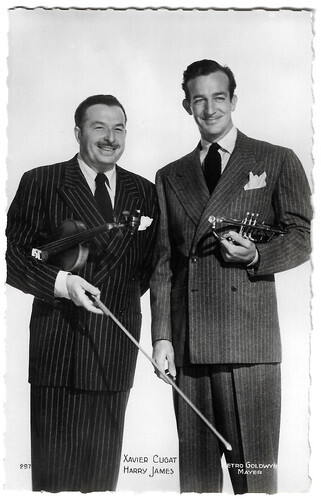
French postcard by Editions P.I., Paris, no. 297. Photo: M.G.M., 1950. With Harry James.
The chachacha, the conga, the mambo and the twist
For sixteen years, Xavier Cugat was the orchestra leader at the Waldorf-Astoria Hotel. From 1932 on, the band performed daily evenings at the hotel's Starlight Roof cabaret, and soon afterwards at the hotel's Start Room matinees. Cugat kept the faithful Nilo Menéndez on piano and percussionist Ray Gonzalez, to whom he added Alberto Calderon on drums and José Piñita on trumpet. His niece, Margo, provided the dance numbers, and Carmen Castillo was the band's singer. One of his trademark gestures was to hold a chihuahua while he waved his baton with the other arm. In the 1930s and 1940s, Xavier Cugat was nicknamed 'The Rumba King' because of his popularisation of that Latin dance. He drew heavily on Cuban music but reworked it to suit American tastes. Although his music now bears little relation to its original roots, Cugat made an important contribution to the spread of Cuban rhythms. He shuttled between New York and Los Angeles for hotel and radio appearances interspersed with film appearances.
Cugat used a variety of singers on his recordings, including Alfredito Valdès, Miguelito Valdès, Connie Francis, and Dinah Shore. His 1940 recording of 'Perfidia' with Miguelito Valdés became a big hit. Cugat was instrumental in bringing Latin music to the attention of the US public. He and his band appeared in several memorable MGM musicals in the 1940s. In such films as You Were Never Lovelier (William A. Seiter, 1942) with Rita Hayworth , Bathing Beauty (George Sidney, 1944), and Week-End at the Waldorf (Robert Z. Leonard, 1945), he usually played himself, even if the character had a name other than Xavier Cugat. Cugat followed new trends closely. For example, he made recordings for the chachacha, the conga, the mambo and the twist at the time they were in vogue. A major hit was 'Brazil,' which reached seventeenth place on the Billboard Hot 100 in 1943. Other well-known songs include 'Bahía' by Ary Barroso, 'Siboney', 'Malagueña', 'Andalucía (The Breeze and I)' by Ernesto Lecuona, 'Tequila' and 'El Cumbachero'.
From 1942 to the summer of 1946, the war kept the orchestra away from the recording studios. It placed itself at the disposal of the American Administration for numerous tours of military camps abroad. In 1947, Xavier Cugat left the Waldorf Astoria with two talented singers in tow: Dean Martin and Jerry Lewis . He toured Venezuela the same year, Peru in 1960 and Bolivia in 1962. In addition to his tours, Cugat appeared in a string of films in the late 1940s. As the head of his orchestra, he could be seen in such musicals as A Date with Judy (Richard Thorpe, 1948), On an Island with You (Richard Thorpe, 1948), and Neptune's Daughter (Edward Buzzell, 1949), starring Esther Williams .
He toured the world with his orchestra, to which he added the female voices of Lorrain Allen, Carmen Miranda , Lina Romay and Abbe Lane . He recruited the latter in 1950 and kept her in his band throughout the decade. The first theme she performed with Cugat was 'The Wedding Samba'. Cugat travelled to almost every country in the world. The secret of his success was always knowing how to adapt Latin American music (which he described as "tropical"), simplifying the themes to make them accessible to the tastes of the audiences he hosted. In 1963, Cugat was deeply affected both sentimentally and musically by the departure of Abbe Lane , but he quickly bounced back by taking on a new singer, Charo, whom he made his fifth wife and appointed as a folk singer.
After suffering a stroke in 1971, Xavier Cugat retired. In 1973, however, he recorded one last double LP with his orchestra, which remains one of his best-selling and most famous records. He lived in Catalonia and continued to paint, draw and caricature. In 1990, he was awarded the Cross of St. George by the Generalitat of Catalonia. Cugat was married five times. His first marriage was to Rita Montaner (1918–1920), his second was to his band vocalist Carmen Castillo (1929–1944), his third to actress Lorraine Allen (1947–1952), his fourth to singer Abbe Lane (1952–1964), and his fifth to Spanish guitarist and comic actress Charo (1966–1978). His last marriage was the first to take place at Caesars Palace on the Las Vegas Strip. In 1990, Cugat died of heart failure at age 90 in Barcelona and was buried in his hometown of Girona. Cugat received a star on the Hollywood Walk of Fame at the address 1500 Vine Street. Several songs Xavier Cugat recorded, including 'Perfidia', were used in the Wong Kar-Wai films A Fei jing juen/Days of Being Wild (1991) and 2046 (2004). His song 'Cui Cui' was featured in the animated feature Happy Feet (George Miller, Warren Coleman, Judy Morris, 2006), about a tap-dancing penguin who can't sing a love song.
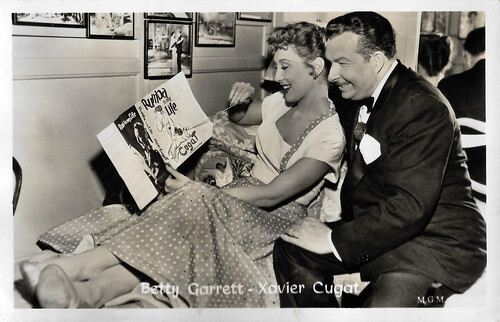
Belgian postcard by Nieuwe Merksemsche Chocolaterie S.P.R.L., Merksem (Antwerp), no. D 17. Photo: MGM. Betty Garrett and Xavier Cugat are studying the artwork for the book 'Rumba is My Life' by Xavier Cugat, published in 1948.
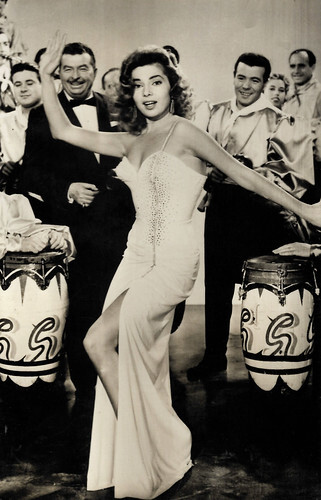
Spanish postcard by Ediciones J.R.B., no. 85/4. Photo: Ceo. Abbe Lane and Xavier Cugat's Orchestra.
Sources: Xavier Cugat i Mingall, Wikipedia (Dutch, German and English) and .

Promotion card by Philips, no. GF 025 66/13.

Dutch postcard. Photo: M.G.M.

Vintage postcard, no. 1151.
The Rumba King at the fashionable Coconut Grove
Xavier Cugat was born Francisco de Asis Javier Cugat Migall de Bru y Deulofeu in 1900 in Girona, Catalonia, Spain. Cugat was born just a few minutes after midnight in the last year of the 19th century. This was considered so remarkable in his home country of Spain that his father, who was a political prisoner at the time, was pardoned and his brothers were exempted from military service. His family moved to Cuba when he was five (or three - sources differ). One of his neighbours was a violin maker who crafted a miniature version of the instrument that would become Cugat's ticket to fame. In Havana, he was trained as a classical violinist and played in cafés. He went on to work at Le Payret cinema, where he provided background music for the silent films shown there. On the recommendation of his violin teacher and after passing an audition, he was hired by the director of the Havana Symphony Orchestra, where he became the first violinist at the age of 12.
In 1915, his family migrated to New York. Like his brother, Francis Cugat (1893-1981), the artist of the famous book cover of 'The Great Gatsby' (1925), he became a graphic designer, more specifically a cartoonist. The Catalan mezzo-soprano Maria Gay introduced the young Xavier to prestigious musicians such as Pau Casals or Enric Granados. Through hard work, Cugat progressed. He met Enrico Caruso, befriended him and accompanied him on his tour of the United States. Caruso got the young man to study with the artistic director of the prestigious Carnegie Hall. Thanks to his contacts in the music world, he could perform at Carnegie Hall, where he met with only moderate success.
At the conservatory, he met Rita Montaner, who studied singing there and they married in 1918 In 1920, the young couple divorced. His family returned to Catalonia, enabling 20-year-old Cugat to study in Germany. In 1924, he returned to the United States. Once again, he appeared at Carnegie Hall. This time the audience gave him a standing ovation, but he still failed to win over the critics. Cugat felt deeply offended. In New York, he met up again with his ex Rita Montaner, and he helped her prepare for Cuban and Antillean music shows. When discovering these shows, he decided to abandon the violin. Montaner founded an orchestra which Cugat directed. In 1926, they were both cast on Broadway in the hit revue 'Una noche en España'.
The following year, he moved to Los Angeles. In California, he worked as a cartoonist for the Los Angeles Times during the day and tried to find members for his band at night. Cugat finally got his break when his combo played at the fashionable Coconut Grove nightclub in Los Angeles and introduced the rumba. Audiences were captivated by the exotic rhythms and sounds of this music that made them shake their hips in an entirely new way. He christened the band 'Xavier Cugat y sus Gigolos' and his style of music caught on. Cugat convinced the owner to hire South American dancers and made the dancers part of his orchestra.
In the late 1920s, the silent film era ended and that of films with sound began. Cugat turned his act into the Vitaphone short A Spanish Ensemble/Xavier Cugat and His Gigolos (1928). In the early 1930s, he appeared with his band in more films such as The Lash (Frank Lloyd, 1930) and In Gay Madrid (Robert Z. Leonard, 1931) starring Ramon Novarro . In 1931, Charles Chaplin asked him to play the violin for one of the musical themes in his film City Lights (Charles Chaplin, 1931). That same year, Cugat hired a 13-year-old dancer, Margarita Carmen Cansino, the future Rita Hayworth , to perform with his band. In 1931 he went with his band to New York for the opening of the Waldorf-Astoria Hotel where he eventually replaced Jack Denny as leader of the resident orchestra.

Belgian postcard. Photo: M.G.M. Jimmy Durante, Peter Lawford , Esther Williams , Cyd Charisse , Ricardo Montalban and Xavier Cugat in On an Island with You (Richard Thorpe, 1948).

French postcard by Editions P.I., Paris, no. 297. Photo: M.G.M., 1950. With Harry James.
The chachacha, the conga, the mambo and the twist
For sixteen years, Xavier Cugat was the orchestra leader at the Waldorf-Astoria Hotel. From 1932 on, the band performed daily evenings at the hotel's Starlight Roof cabaret, and soon afterwards at the hotel's Start Room matinees. Cugat kept the faithful Nilo Menéndez on piano and percussionist Ray Gonzalez, to whom he added Alberto Calderon on drums and José Piñita on trumpet. His niece, Margo, provided the dance numbers, and Carmen Castillo was the band's singer. One of his trademark gestures was to hold a chihuahua while he waved his baton with the other arm. In the 1930s and 1940s, Xavier Cugat was nicknamed 'The Rumba King' because of his popularisation of that Latin dance. He drew heavily on Cuban music but reworked it to suit American tastes. Although his music now bears little relation to its original roots, Cugat made an important contribution to the spread of Cuban rhythms. He shuttled between New York and Los Angeles for hotel and radio appearances interspersed with film appearances.
Cugat used a variety of singers on his recordings, including Alfredito Valdès, Miguelito Valdès, Connie Francis, and Dinah Shore. His 1940 recording of 'Perfidia' with Miguelito Valdés became a big hit. Cugat was instrumental in bringing Latin music to the attention of the US public. He and his band appeared in several memorable MGM musicals in the 1940s. In such films as You Were Never Lovelier (William A. Seiter, 1942) with Rita Hayworth , Bathing Beauty (George Sidney, 1944), and Week-End at the Waldorf (Robert Z. Leonard, 1945), he usually played himself, even if the character had a name other than Xavier Cugat. Cugat followed new trends closely. For example, he made recordings for the chachacha, the conga, the mambo and the twist at the time they were in vogue. A major hit was 'Brazil,' which reached seventeenth place on the Billboard Hot 100 in 1943. Other well-known songs include 'Bahía' by Ary Barroso, 'Siboney', 'Malagueña', 'Andalucía (The Breeze and I)' by Ernesto Lecuona, 'Tequila' and 'El Cumbachero'.
From 1942 to the summer of 1946, the war kept the orchestra away from the recording studios. It placed itself at the disposal of the American Administration for numerous tours of military camps abroad. In 1947, Xavier Cugat left the Waldorf Astoria with two talented singers in tow: Dean Martin and Jerry Lewis . He toured Venezuela the same year, Peru in 1960 and Bolivia in 1962. In addition to his tours, Cugat appeared in a string of films in the late 1940s. As the head of his orchestra, he could be seen in such musicals as A Date with Judy (Richard Thorpe, 1948), On an Island with You (Richard Thorpe, 1948), and Neptune's Daughter (Edward Buzzell, 1949), starring Esther Williams .
He toured the world with his orchestra, to which he added the female voices of Lorrain Allen, Carmen Miranda , Lina Romay and Abbe Lane . He recruited the latter in 1950 and kept her in his band throughout the decade. The first theme she performed with Cugat was 'The Wedding Samba'. Cugat travelled to almost every country in the world. The secret of his success was always knowing how to adapt Latin American music (which he described as "tropical"), simplifying the themes to make them accessible to the tastes of the audiences he hosted. In 1963, Cugat was deeply affected both sentimentally and musically by the departure of Abbe Lane , but he quickly bounced back by taking on a new singer, Charo, whom he made his fifth wife and appointed as a folk singer.
After suffering a stroke in 1971, Xavier Cugat retired. In 1973, however, he recorded one last double LP with his orchestra, which remains one of his best-selling and most famous records. He lived in Catalonia and continued to paint, draw and caricature. In 1990, he was awarded the Cross of St. George by the Generalitat of Catalonia. Cugat was married five times. His first marriage was to Rita Montaner (1918–1920), his second was to his band vocalist Carmen Castillo (1929–1944), his third to actress Lorraine Allen (1947–1952), his fourth to singer Abbe Lane (1952–1964), and his fifth to Spanish guitarist and comic actress Charo (1966–1978). His last marriage was the first to take place at Caesars Palace on the Las Vegas Strip. In 1990, Cugat died of heart failure at age 90 in Barcelona and was buried in his hometown of Girona. Cugat received a star on the Hollywood Walk of Fame at the address 1500 Vine Street. Several songs Xavier Cugat recorded, including 'Perfidia', were used in the Wong Kar-Wai films A Fei jing juen/Days of Being Wild (1991) and 2046 (2004). His song 'Cui Cui' was featured in the animated feature Happy Feet (George Miller, Warren Coleman, Judy Morris, 2006), about a tap-dancing penguin who can't sing a love song.

Belgian postcard by Nieuwe Merksemsche Chocolaterie S.P.R.L., Merksem (Antwerp), no. D 17. Photo: MGM. Betty Garrett and Xavier Cugat are studying the artwork for the book 'Rumba is My Life' by Xavier Cugat, published in 1948.

Spanish postcard by Ediciones J.R.B., no. 85/4. Photo: Ceo. Abbe Lane and Xavier Cugat's Orchestra.
Sources: Xavier Cugat i Mingall, Wikipedia (Dutch, German and English) and .
Published on May 06, 2024 22:00
May 5, 2024
Eleanor Powell
American dancer and actress Eleanor Powell (1912-1982) was nicknamed 'The world's greatest tap dancer'. In the 1930s and 1940s, she starred in such musicals as Born to Dance (1936), Broadway Melody of 1938 (1937), Rosalie (1937), Honolulu (1939), and Broadway Melody of 1940 (1940). Powell was one of Fred Astaire's favourite dance partners. Their dancing to Cole Porter's 'Begin the Beguine' is one of the most extraordinary tap numbers in cinema history.
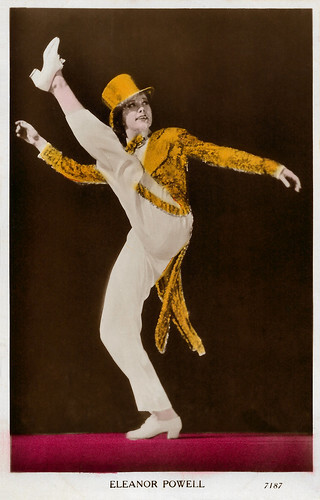
British postcard by Valentine's, no. 7187. Photo: Metro-Goldwyn-Mayer. Eleanor Powell in Broadway Melody of 1936 (Roy Del Ruth, 1935). Caption: Eleanor Powell who is described as the 'World's Greatest Feminine Tap Dancer' is here seen doing 'The Broadway Rhythm' in Broadway Melody of 1936, Metro-Goldwyn-Mayer's latest film.
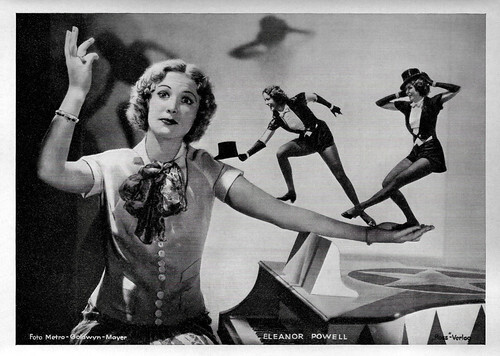
Big German card by Ross Verlag. Photo: Ted Allan / Metro-Goldwyn-Mayer. Eleanor Powell in Born to Dance (Roy Del Ruth, 1936).
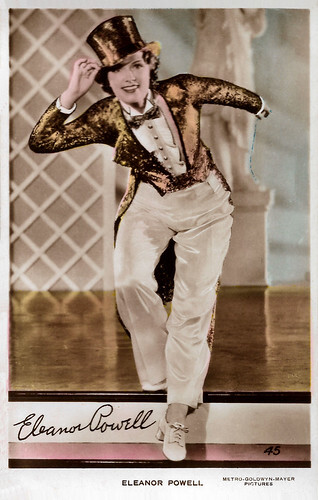
British Art Photo postcard, no. 45. Photo: Metro-Goldwyn-Mayer.
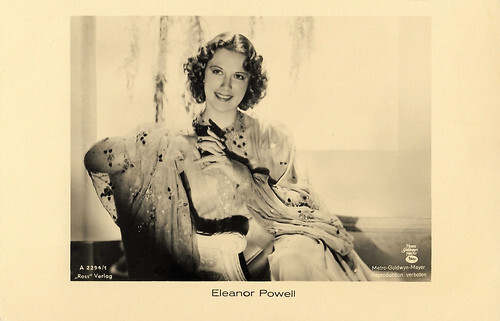
German postcard by Ross Verlag, no. A 2294/1, 1939-1940. Photo: Metro-Goldwyn-Mayer. Sent by mail in 1939.
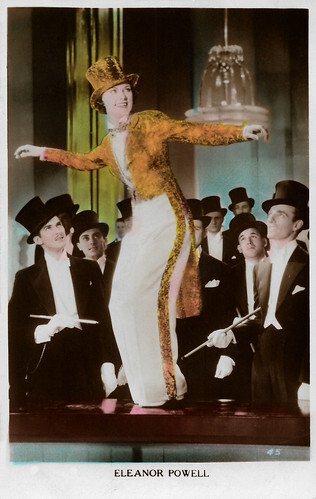
British Art Photo postcard, no. 45. Photo: Metro-Goldwyn-Mayer. Eleanor Powell in Lady Be Good (Norman Z. McLeod, Busby Berkeley, 1941).
Playing the floor as if it were an instrument
Eleanor Torrey Powell was born in Springfield, Massachusetts in 1912. Her parents were Clarence Gardner Powell and Blanche Torrey Powell. Her father left her and her mother when she was two years old. She was raised by her mother with the help of her maternal grandparents who lived with them. Eleanor was a painfully shy child, not even able to greet guests who would come into her family’s own house. She learnt ballet to combat her shyness.
At the age of eleven, she was discovered by Gus Edwards, the owner of the 'Vaudeville Kiddie Review'. She subsequently began working her first paid gigs for Edwards, during her summer holidays. In 1928, Powell began a package of ten tap lessons at a school run by Jack Donahue and Johnny Boyle. These lessons would be the only formal tap training she would ever have. In training Powell, Donohue and Boyle used an unconventional method.
Wikipedia : "To counteract her tendency toward pulling away from the floor and working through her feet, as one does in classical ballet and acrobatics, they had her wear an army surplus belt during her lessons, which had one sandbag attached on either side. This was intended to weigh her down, help her to feel the floor differently, and engage with it – to 'play' the floor as if it were an instrument. This not only served to help Powell 'find her legs' in tap dance, it also was to be a catalyst in the development of her uniquely grounded and smooth tap style."
When she was seventeen, Powell made the move to Broadway where she made her debut in the revue 'The Optimists'. She starred in several musicals on Broadway and quickly became a renowned performer, nicknamed 'The world's greatest tap dancer'. In 1930, Eleanor Powell's first film in Hollywood, Queen High (Fred C. Newmeyer, 1930) was unsuccessful. On Broadway, she had more success in the musicals 'Fine and Dandy' (1930) and 'At Home Abroad' (1935).
She returned to Hollywood to perform a 'specialty dance' in the Fox musical George White's 1935 Scandals (George White, 1935). It was a major film debut for the young dancer. According to Powell's introduction to the book 'Gotta Sing, Gotta Dance', a mix-up in the make-up department resulted in her being made to look almost Egyptian. She left the production so disenchanted with film-making, that she initially rejected a contract offer by MGM.
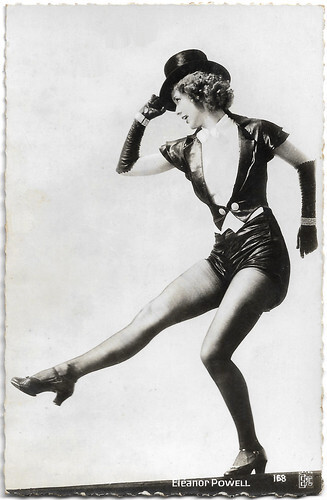
French postcard by Editions et Publications cinématographiques (EPC), no. 168.
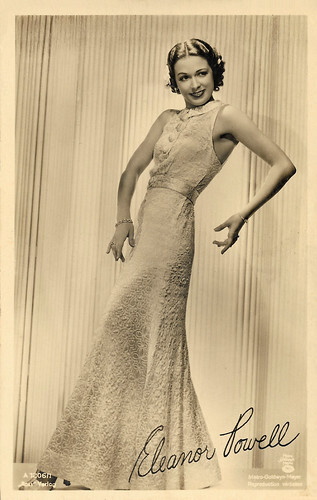
German postcard by Ross Verlag, no. A 1206/1, 1937-1938. Photo: Metro-Goldwyn-Mayer.
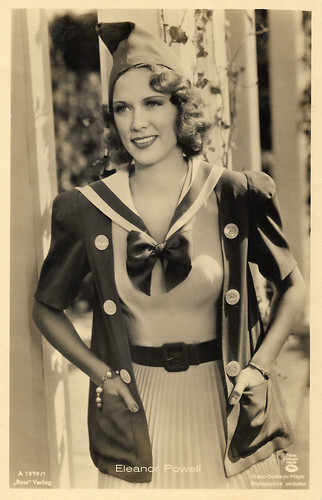
German postcard by Ross Verlag, no. A 1974/1, 1937-1938. Photo: Metro-Goldwyn-Mayer.
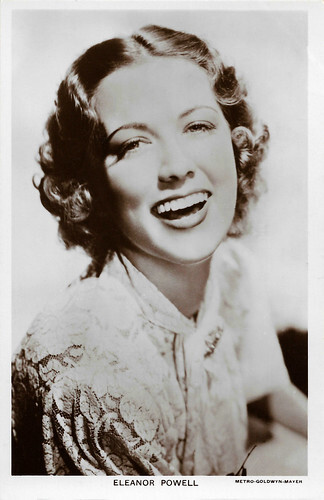
British postcard in the Picturegoer Series, London, no. 1036a. Photo: Metro-Goldwyn-Mayer.
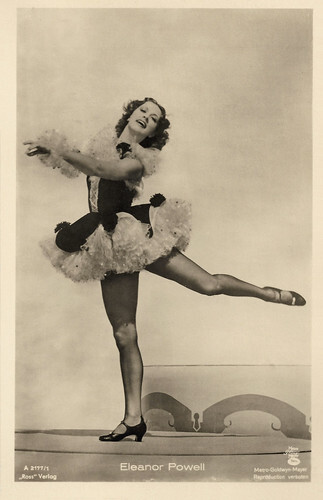
German postcard by Ross Verlag, no. A 2177/1, 1939-1940. Photo: Metro-Goldwyn-Mayer.
One of the best tap dance scenes in the history of film
Later in the year, MGM placed Eleanor Powell in the popular musical Broadway Melody of 1936 (Roy Del Ruth, 1935) with Jack Benny. The film was nominated for the Academy Award for Best Picture. According to dancer Ann Miller , quoted in the 'making-of' documentary That's Entertainment! III, MGM was headed for bankruptcy at the time, but the films of Eleanor Powell, particularly Broadway Melody of 1936, were so popular that they made the company profitable again.
Powell's lavish musicals including Born to Dance (Roy Del Ruth, 1936) with James Stewart , Rosalie (W.S. Van Dyke, 1937) with Nelson Eddy, Broadway Melody of 1938 (Roy Del Ruth, 1937) with Robert Taylor and Honolulu (Edward Buzzell, 1939) proved extremely lucrative. Powell tap-danced in almost all her films. Her singing scenes, on the other hand, were always dubbed.
The highlight of her career came in 1940 when she featured alongside Fred Astaire in Broadway Melody of 1940 (Norman Taurog, 1940). Their scene 'Begin the Beguine' with music by Cole Porter is recognised by several critics as one of the best tap dance scenes in the history of film. Film historians wrote that Powell was the only dancer by whom Astaire was dwarfed. Shortly after the premiere of this film, Powell had to undergo an ulcer operation.
After this, her popularity went downhill. She got smaller and smaller roles in films and missed out on more and more film roles, including the leading role in For Me and My Gal (Busby Berkeley, 1942). After a cameo in Thousands Cheer (George Sidney, 1943), she left MGM. Later that year, she married Glenn Ford . When she had a son, Peter Ford, she decided to retire. She made a one-off trip to the studio, for a cameo in Duchess of Idaho (Robert Z. Leonard, 1950), starring Esther Williams and Van Johnson. Powell later made another career in the television industry and she joined the Unity Church. Shortly after her divorce from Ford in 1959, she opened her nightclub, which received a lot of publicity.
In 1974, Powell was reintroduced to audiences in the popular compilation film That's Entertainment! (Jack Haley Jr., 1974) and its sequels That's Entertainment Part II (Jack Haley Jr., 1976) and That's Entertainment! III (Bud Friedgen, Michael J. Sheridan, 1994) and the related film That's Dancing! (Jack Haley Jr., 1985) which spotlights her dancing in films such as Broadway Melody of 1940 (Norman Taurog, 1940), Lady Be Good (Norman Z. McLeod, 1941), and Born to Dance (Roy Del Ruth, 1936). Powell made her last public appearance in 1981 when she attended a televised American Film Institute tribute to Fred Astaire . Upon her entry, she received a standing ovation. A year later, in 1982, Eleanor Powell died of ovarian cancer in Beverly Hills, California, at the age of 69. She is buried at Hollywood Forever Cemetery in Los Angeles.
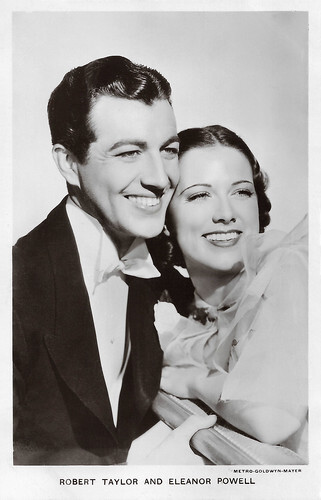
British postcard in the Film Partner Series, London, no. P. 186. Photo: Metro-Goldwyn-Mayer. Robert Taylor and Eleanor Powell in Broadway Melody of 1938 (Roy Del Ruth, 1937).
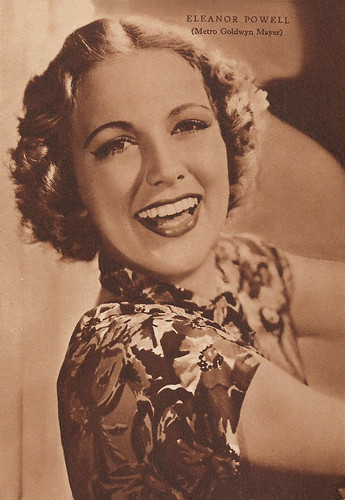
Italian postcard by Rizzoli & C. Milano, 1938. Photo: Metro-Goldwyn-Mayer.
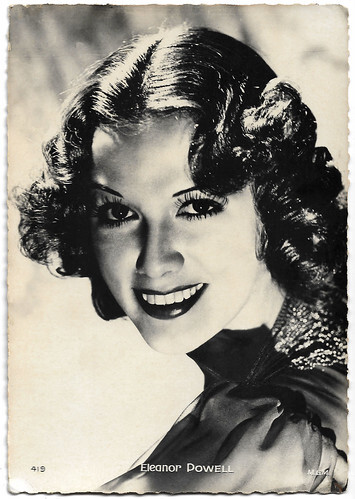
French postcard by Collection Chantal, Paris, no. 419. Photo: Metro-Goldwyn-Mayer.
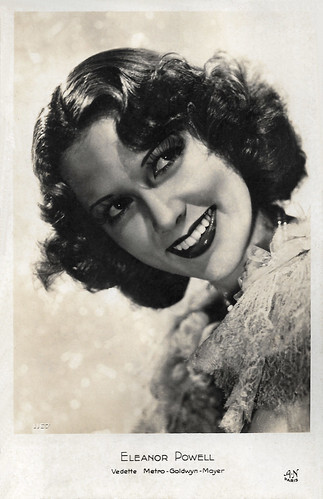
French postcard by A.N., Paris, no. 1157. Photo: Metro-Goldwyn-Mayer.
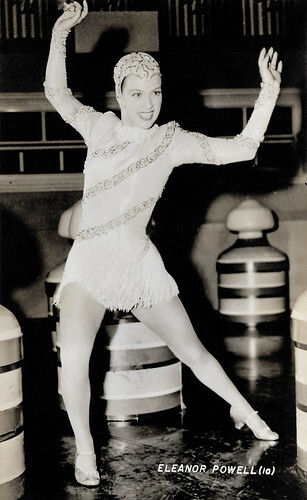
Vintage postcard.
Sources: Wikipedia (Dutch, French and English) and .

British postcard by Valentine's, no. 7187. Photo: Metro-Goldwyn-Mayer. Eleanor Powell in Broadway Melody of 1936 (Roy Del Ruth, 1935). Caption: Eleanor Powell who is described as the 'World's Greatest Feminine Tap Dancer' is here seen doing 'The Broadway Rhythm' in Broadway Melody of 1936, Metro-Goldwyn-Mayer's latest film.

Big German card by Ross Verlag. Photo: Ted Allan / Metro-Goldwyn-Mayer. Eleanor Powell in Born to Dance (Roy Del Ruth, 1936).

British Art Photo postcard, no. 45. Photo: Metro-Goldwyn-Mayer.

German postcard by Ross Verlag, no. A 2294/1, 1939-1940. Photo: Metro-Goldwyn-Mayer. Sent by mail in 1939.

British Art Photo postcard, no. 45. Photo: Metro-Goldwyn-Mayer. Eleanor Powell in Lady Be Good (Norman Z. McLeod, Busby Berkeley, 1941).
Playing the floor as if it were an instrument
Eleanor Torrey Powell was born in Springfield, Massachusetts in 1912. Her parents were Clarence Gardner Powell and Blanche Torrey Powell. Her father left her and her mother when she was two years old. She was raised by her mother with the help of her maternal grandparents who lived with them. Eleanor was a painfully shy child, not even able to greet guests who would come into her family’s own house. She learnt ballet to combat her shyness.
At the age of eleven, she was discovered by Gus Edwards, the owner of the 'Vaudeville Kiddie Review'. She subsequently began working her first paid gigs for Edwards, during her summer holidays. In 1928, Powell began a package of ten tap lessons at a school run by Jack Donahue and Johnny Boyle. These lessons would be the only formal tap training she would ever have. In training Powell, Donohue and Boyle used an unconventional method.
Wikipedia : "To counteract her tendency toward pulling away from the floor and working through her feet, as one does in classical ballet and acrobatics, they had her wear an army surplus belt during her lessons, which had one sandbag attached on either side. This was intended to weigh her down, help her to feel the floor differently, and engage with it – to 'play' the floor as if it were an instrument. This not only served to help Powell 'find her legs' in tap dance, it also was to be a catalyst in the development of her uniquely grounded and smooth tap style."
When she was seventeen, Powell made the move to Broadway where she made her debut in the revue 'The Optimists'. She starred in several musicals on Broadway and quickly became a renowned performer, nicknamed 'The world's greatest tap dancer'. In 1930, Eleanor Powell's first film in Hollywood, Queen High (Fred C. Newmeyer, 1930) was unsuccessful. On Broadway, she had more success in the musicals 'Fine and Dandy' (1930) and 'At Home Abroad' (1935).
She returned to Hollywood to perform a 'specialty dance' in the Fox musical George White's 1935 Scandals (George White, 1935). It was a major film debut for the young dancer. According to Powell's introduction to the book 'Gotta Sing, Gotta Dance', a mix-up in the make-up department resulted in her being made to look almost Egyptian. She left the production so disenchanted with film-making, that she initially rejected a contract offer by MGM.

French postcard by Editions et Publications cinématographiques (EPC), no. 168.

German postcard by Ross Verlag, no. A 1206/1, 1937-1938. Photo: Metro-Goldwyn-Mayer.

German postcard by Ross Verlag, no. A 1974/1, 1937-1938. Photo: Metro-Goldwyn-Mayer.

British postcard in the Picturegoer Series, London, no. 1036a. Photo: Metro-Goldwyn-Mayer.

German postcard by Ross Verlag, no. A 2177/1, 1939-1940. Photo: Metro-Goldwyn-Mayer.
One of the best tap dance scenes in the history of film
Later in the year, MGM placed Eleanor Powell in the popular musical Broadway Melody of 1936 (Roy Del Ruth, 1935) with Jack Benny. The film was nominated for the Academy Award for Best Picture. According to dancer Ann Miller , quoted in the 'making-of' documentary That's Entertainment! III, MGM was headed for bankruptcy at the time, but the films of Eleanor Powell, particularly Broadway Melody of 1936, were so popular that they made the company profitable again.
Powell's lavish musicals including Born to Dance (Roy Del Ruth, 1936) with James Stewart , Rosalie (W.S. Van Dyke, 1937) with Nelson Eddy, Broadway Melody of 1938 (Roy Del Ruth, 1937) with Robert Taylor and Honolulu (Edward Buzzell, 1939) proved extremely lucrative. Powell tap-danced in almost all her films. Her singing scenes, on the other hand, were always dubbed.
The highlight of her career came in 1940 when she featured alongside Fred Astaire in Broadway Melody of 1940 (Norman Taurog, 1940). Their scene 'Begin the Beguine' with music by Cole Porter is recognised by several critics as one of the best tap dance scenes in the history of film. Film historians wrote that Powell was the only dancer by whom Astaire was dwarfed. Shortly after the premiere of this film, Powell had to undergo an ulcer operation.
After this, her popularity went downhill. She got smaller and smaller roles in films and missed out on more and more film roles, including the leading role in For Me and My Gal (Busby Berkeley, 1942). After a cameo in Thousands Cheer (George Sidney, 1943), she left MGM. Later that year, she married Glenn Ford . When she had a son, Peter Ford, she decided to retire. She made a one-off trip to the studio, for a cameo in Duchess of Idaho (Robert Z. Leonard, 1950), starring Esther Williams and Van Johnson. Powell later made another career in the television industry and she joined the Unity Church. Shortly after her divorce from Ford in 1959, she opened her nightclub, which received a lot of publicity.
In 1974, Powell was reintroduced to audiences in the popular compilation film That's Entertainment! (Jack Haley Jr., 1974) and its sequels That's Entertainment Part II (Jack Haley Jr., 1976) and That's Entertainment! III (Bud Friedgen, Michael J. Sheridan, 1994) and the related film That's Dancing! (Jack Haley Jr., 1985) which spotlights her dancing in films such as Broadway Melody of 1940 (Norman Taurog, 1940), Lady Be Good (Norman Z. McLeod, 1941), and Born to Dance (Roy Del Ruth, 1936). Powell made her last public appearance in 1981 when she attended a televised American Film Institute tribute to Fred Astaire . Upon her entry, she received a standing ovation. A year later, in 1982, Eleanor Powell died of ovarian cancer in Beverly Hills, California, at the age of 69. She is buried at Hollywood Forever Cemetery in Los Angeles.

British postcard in the Film Partner Series, London, no. P. 186. Photo: Metro-Goldwyn-Mayer. Robert Taylor and Eleanor Powell in Broadway Melody of 1938 (Roy Del Ruth, 1937).

Italian postcard by Rizzoli & C. Milano, 1938. Photo: Metro-Goldwyn-Mayer.

French postcard by Collection Chantal, Paris, no. 419. Photo: Metro-Goldwyn-Mayer.

French postcard by A.N., Paris, no. 1157. Photo: Metro-Goldwyn-Mayer.

Vintage postcard.
Sources: Wikipedia (Dutch, French and English) and .
Published on May 05, 2024 22:00
May 4, 2024
André Le Gall
André Le Gall (1917-1974) was a French stage and screen actor, who peaked in the French cinema of the 1940s and 1950s.
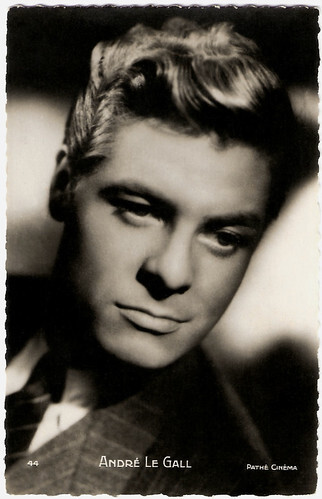
French postcard by Editions P.I., Paris, no. 44. Photo: Pathé Cinema.
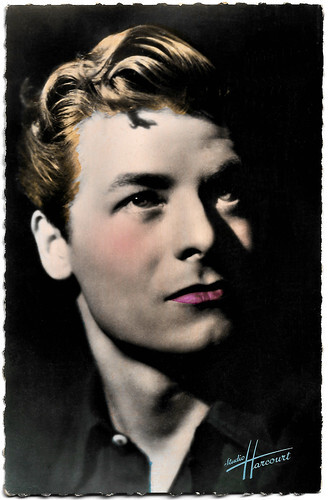
French postcard. Photo: Studio Harcourt.
The biggest box office hit after La grande illusion
Born in Paris in 1917, André Le Gall debuted - as far as known - both on stage and on-screen during the German Occupation of France. He played a censured and cut part in La Cavalcade des heures/Love Around the Clock (Yvan Noé, 1943) starring Gaby Morlay , Fernandel and singer Charles Trenet and had an uncredited part in the comedy Adieu Léonard/Goodbye Leonard (Pierre Prévert, 1943) starring Charles Trenet .
Le Gall quickly rose to stardom with the lead role opposite Irène Corday in Premier de cordée/First on the Rope (Louis Daquin, 1944), about a young aspiring mountain man whose career plans are thwarted by an accident, causing him vertigo. Two years later when his father, a veteran mountain climber, is persuaded by a Norwegian tourist to take him on a trip into the mountains, his son is forced to come to their rescue when they run into trouble during a storm.
The mountain drama was filmed on location around Mont Blanc in the French Alps, with real mountaineers and without special effects. It glorifies the landscape, similar to the previous mountain films by Luis Trenker , deviating from the many indoor-shot studio films from those days. Wikipedia: "Despite being directed by Louis Daquin, a French Communist, it was considered to demonstrate a Pétainist ideology possibly even containing elements of Nazism." Shot in 1943, the film was released in France in early 1944.
After the war, André Le Gall had a supporting part as the Breton Quérec in Le Bataillon du ciel/They are not Angels (Alexandre Esway, 1947), a two-part film based on a novel by Joseph Kessel. It's the story of a French parachute battalion of the Special Air Service was dropped on Brittany to help the Resistance contain the enemy forces en route to Normandy in 1944. Le Bataillon du ciel was filmed in 1945 but released in France in 1947.
Le Bataillon du ciel/They are not Angels was and is one of the biggest French box office hits, starring Pierre Blanchar and René Lefèvre . At the time of its release, it was the biggest box office hit after Jean Renoir 's La grande illusion/The Grand Illusion (1937).
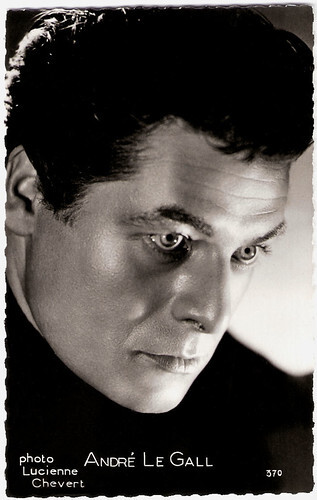
French postcard by Editions P.I., Paris, offered by Les Carbones Korès, no. 370. Photo: Lucienne Chevert.
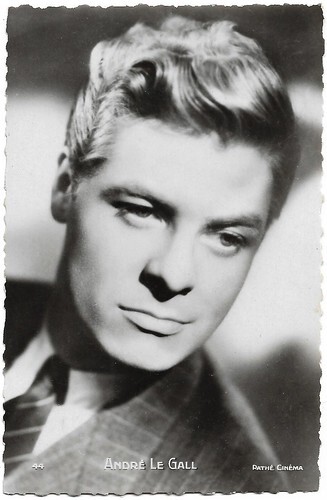
French postcard, no. 44. Photo: Pathé Cinéma.
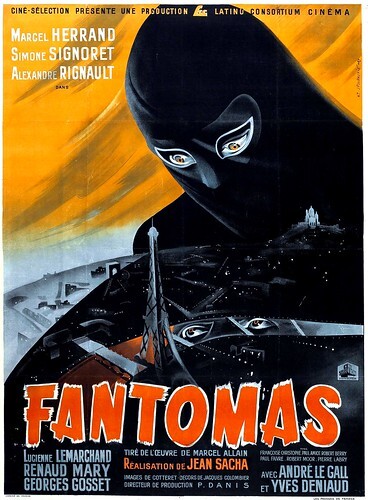
French poster for Fantômas (Jean Sacha, 1947). Collection: Philippe Freyhof@Flickr.
A major part as the journalist Fandor in Fantômas
After the short L'assassin était trop familier/The Assassin was All Too Familiar (Raymond Leboursier, 1946), André Le Gall played a major part as the journalist Fandor in Fantômas (Jean Sacha, 1947). The film features the fictional master criminal Fantômas, created in 1911 by Marcel Allain and Pierre Souvestre. The film was a rather cheaply made 'policier' with Marcel Herrand in the title role and Alexandre Rignault as commissaire Juve.
Next, Le Gall was Albert Préjean 's antagonist in La Grande Volière/The large aviary (Georges Péclet, 1947) and had a major part in the smugglers' film Passeurs d'or/Gold Smugglers (Émile-Georges De Meyst, 1948), starring Ginette Leclerc . It was Pathé's biggest French box-office success in 1948.
In 1949 he had leads as a diver in L'Épave/Sin and Desire (Willy Rozier, 1949), opposite Françoise Arnoul, and as a professional cyclist in Drame au Vel'd'Hiv'/Crime at the velodrome (Maurice Cam, 1949), opposite Claude Farell . He also had supporting parts in Le Cas du docteur Galloy/The Case of Doctor Galloy (Maurice Téboul, 1949, released in 1951), and Prélude à la gloire/Prelude to Glory (Georges Lacombe, 1950), the film that turned musical child prodigy Roberto Benzi into a star.
In the early 1950s, Le Gall still had major parts, e.g. as Raymond Pellegrin 's antagonist in the mystery Coupable?/Guilty? (Yvan Noé, 1951), and as a retired criminal forced to kill a gangster moll in the thriller Opération Magali/Operation Magali (László V. Kish, 1953). Later, Le Gall was absent from the sets almost all through the late fifties and completely during the sixties.
André Le Gall returned to the screen in the early 1970s as the counsellor in Jean-Pierre Mocky's thriller L'Albatros/Love Hate (1971) and had a few minor parts in TV series. In 1974, André Le Gall died at 57 in Bois-Colombes, Hauts-de-Seine.
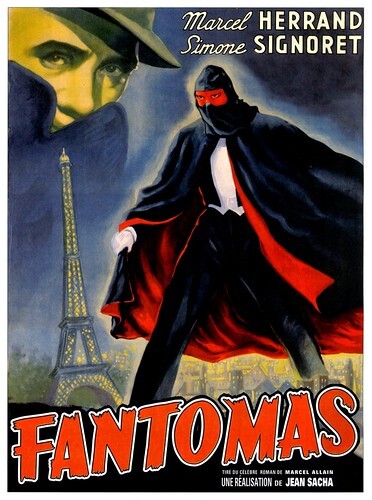
French poster for Fantômas (Jean Sacha, 1947). Collection: Philippe Freyhof@Flickr.
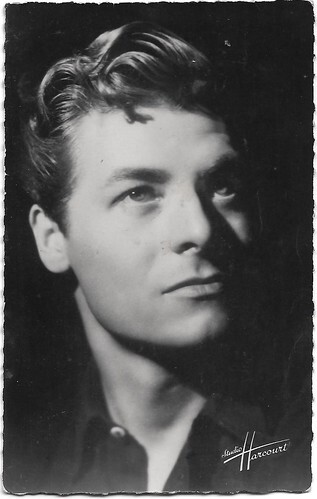
French postcard. Photo: Studio Harcourt.
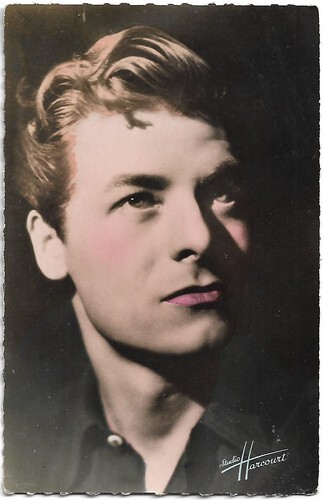
French postcard. Photo: Studio Harcourt.
Sources: Wikipedia (French and English) and .

French postcard by Editions P.I., Paris, no. 44. Photo: Pathé Cinema.

French postcard. Photo: Studio Harcourt.
The biggest box office hit after La grande illusion
Born in Paris in 1917, André Le Gall debuted - as far as known - both on stage and on-screen during the German Occupation of France. He played a censured and cut part in La Cavalcade des heures/Love Around the Clock (Yvan Noé, 1943) starring Gaby Morlay , Fernandel and singer Charles Trenet and had an uncredited part in the comedy Adieu Léonard/Goodbye Leonard (Pierre Prévert, 1943) starring Charles Trenet .
Le Gall quickly rose to stardom with the lead role opposite Irène Corday in Premier de cordée/First on the Rope (Louis Daquin, 1944), about a young aspiring mountain man whose career plans are thwarted by an accident, causing him vertigo. Two years later when his father, a veteran mountain climber, is persuaded by a Norwegian tourist to take him on a trip into the mountains, his son is forced to come to their rescue when they run into trouble during a storm.
The mountain drama was filmed on location around Mont Blanc in the French Alps, with real mountaineers and without special effects. It glorifies the landscape, similar to the previous mountain films by Luis Trenker , deviating from the many indoor-shot studio films from those days. Wikipedia: "Despite being directed by Louis Daquin, a French Communist, it was considered to demonstrate a Pétainist ideology possibly even containing elements of Nazism." Shot in 1943, the film was released in France in early 1944.
After the war, André Le Gall had a supporting part as the Breton Quérec in Le Bataillon du ciel/They are not Angels (Alexandre Esway, 1947), a two-part film based on a novel by Joseph Kessel. It's the story of a French parachute battalion of the Special Air Service was dropped on Brittany to help the Resistance contain the enemy forces en route to Normandy in 1944. Le Bataillon du ciel was filmed in 1945 but released in France in 1947.
Le Bataillon du ciel/They are not Angels was and is one of the biggest French box office hits, starring Pierre Blanchar and René Lefèvre . At the time of its release, it was the biggest box office hit after Jean Renoir 's La grande illusion/The Grand Illusion (1937).

French postcard by Editions P.I., Paris, offered by Les Carbones Korès, no. 370. Photo: Lucienne Chevert.

French postcard, no. 44. Photo: Pathé Cinéma.

French poster for Fantômas (Jean Sacha, 1947). Collection: Philippe Freyhof@Flickr.
A major part as the journalist Fandor in Fantômas
After the short L'assassin était trop familier/The Assassin was All Too Familiar (Raymond Leboursier, 1946), André Le Gall played a major part as the journalist Fandor in Fantômas (Jean Sacha, 1947). The film features the fictional master criminal Fantômas, created in 1911 by Marcel Allain and Pierre Souvestre. The film was a rather cheaply made 'policier' with Marcel Herrand in the title role and Alexandre Rignault as commissaire Juve.
Next, Le Gall was Albert Préjean 's antagonist in La Grande Volière/The large aviary (Georges Péclet, 1947) and had a major part in the smugglers' film Passeurs d'or/Gold Smugglers (Émile-Georges De Meyst, 1948), starring Ginette Leclerc . It was Pathé's biggest French box-office success in 1948.
In 1949 he had leads as a diver in L'Épave/Sin and Desire (Willy Rozier, 1949), opposite Françoise Arnoul, and as a professional cyclist in Drame au Vel'd'Hiv'/Crime at the velodrome (Maurice Cam, 1949), opposite Claude Farell . He also had supporting parts in Le Cas du docteur Galloy/The Case of Doctor Galloy (Maurice Téboul, 1949, released in 1951), and Prélude à la gloire/Prelude to Glory (Georges Lacombe, 1950), the film that turned musical child prodigy Roberto Benzi into a star.
In the early 1950s, Le Gall still had major parts, e.g. as Raymond Pellegrin 's antagonist in the mystery Coupable?/Guilty? (Yvan Noé, 1951), and as a retired criminal forced to kill a gangster moll in the thriller Opération Magali/Operation Magali (László V. Kish, 1953). Later, Le Gall was absent from the sets almost all through the late fifties and completely during the sixties.
André Le Gall returned to the screen in the early 1970s as the counsellor in Jean-Pierre Mocky's thriller L'Albatros/Love Hate (1971) and had a few minor parts in TV series. In 1974, André Le Gall died at 57 in Bois-Colombes, Hauts-de-Seine.

French poster for Fantômas (Jean Sacha, 1947). Collection: Philippe Freyhof@Flickr.

French postcard. Photo: Studio Harcourt.

French postcard. Photo: Studio Harcourt.
Sources: Wikipedia (French and English) and .
Published on May 04, 2024 22:00
May 3, 2024
Sterling Hayden
American actor Sterling Hayden (1916-1986) specialised in Westerns and Film Noirs throughout the 1950s. He is best known for his role as the deranged General Jack D. Ripper in Stanley Kubrick's Dr. Strangelove (1964). Hayden loved boating, and his passion dominated much of his life.
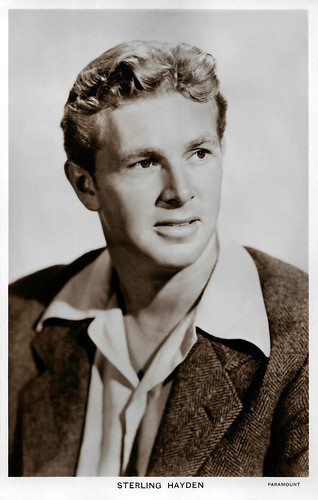
British postcard in the Picturegoer Series, London, no. W 52. Photo: Paramount.
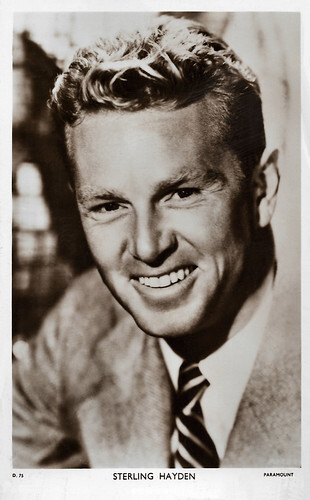
British postcard in the Picturegoer Series, London, no. D. 75. Photo: Paramount.
The Beautiful Blond Viking God
Sterling Hayden was born Sterling Reylea Walter in Upper Montclair, New Jersey in 1916. He was the son of George Walter and Frances Simonson. In 1925, when he was only nine years old, his father died. His stepfather James Hayden adopted him, and his name was changed to Sterling Walter Hayden. In his youth, he lived in New Hampshire, Massachusetts, Pennsylvania, Washington D.C. and Maine, among other places.
Hayden was certainly not of wealthy stock, yet he attended Wassookeag School, a preparatory school in Dexter, Maine, until he was seventeen. After that, he fled to the sea. He worked aboard ships, first as a cabin boy on a schooner, later as a fisherman on the waters around Newfoundland and even as a fireman. In 1935, he received his first command. He sailed the world several times and became a ship captain at 22.
The young captain stood out greatly for his qualities as a captain and his height (1m96), blond hair and muscular body. Hayden wanted to own his boat and decided to moonlight in the modelling world, prompting Paramount Pictures to call and offer a screen test. Hayden did a test in New York with Jeanne Cagney, James Cagney 's sister. In 1940, he signed a seven-year contract with Paramount beginning at $250 a week. The studio began advertising him as 'The Most Beautiful Man in the Movies!' and 'The Beautiful Blond Viking God'.
In his first film, Virginia (Edward H. Griffith, 1941), he starred with one of Paramount's best-known actresses, Madeleine Carroll . The two fell in love and married. After a second film with Carroll, Bahama Passage (Edward H. Griffith, 1941), Hayden left Hollywood to work as an undercover agent for William J. Donovan's Office of Strategic Services - the predecessor of the CIA -, where he remained when it changed to the Office of Strategic Services (OSS). When the United States was attacked at Pearl Harbor during World War II, Hayden joined the Marines under the pseudonym John Hamilton to obscure his Hollywood past.
He went to Europe, where he smuggled weapons and supplies through the German line to the Yugoslav resistance and parachuted over fascist Croatia. Hayden befriended Yugoslav communists and received a Silver Star for his achievements and a commendation from Josip Broz Tito. After returning to the US, he continued acting. He was cast as one of several brothers in an aviation film, Blaze of Noon (John Farrow, 1947). The studio suspended him when he turned down a role in The Sainted Sisters. In 1946, he joined the Communist Party for six months. When McCarthyism took hold of America in 1951, Hayden admitted before the House Committee on Un-American Activities that he had ties to Communism. He also named some names. Hayden always regretted his actions, which he saw as a betrayal, and later wrote in his autobiography that he greatly despised himself around that time.
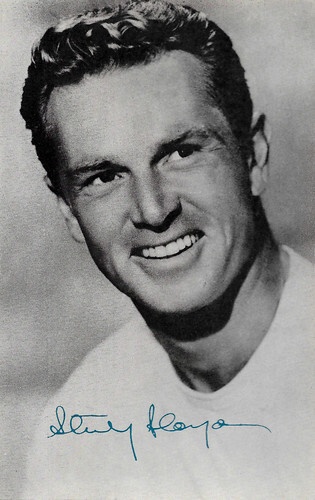
British postcard in the Celebrity Autograph Series, no. 189. Photo: Republic. Sterling Hayden in Timberjack (Joseph Kane, 1955).
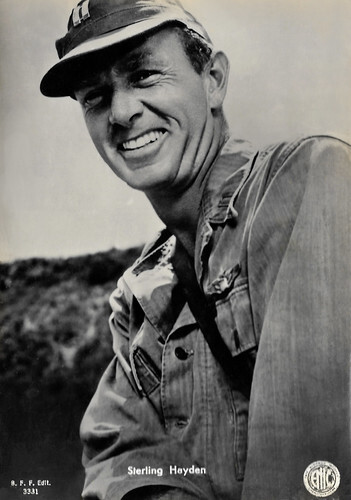
Italian postcard by B.F.F. Edit., no. 3331. Photo: ENIC. Sterling Hayden in Battle Taxi (Herbert L. Strock, 1955).
The Wanderer
After several unsuccessful roles for Paramount, Hayden went freelance, although he did not enjoy the film world. He invested the money he earned in ship projects. During the 1950s, he starred in several Westerns and Film Noirs. Hayden had a starring role in John Huston 's Noir classic The Asphalt Jungle (1950), for which he received excellent reviews. He had a support role in a big studio picture, Prince Valiant (Henry Hathway, 1954), playing Sir Gawain.
That year, he acted in Nicholas Ray's Western Johnny Guitar (1954), starring Joan Crawford . It was a box office hit and became a cult favourite. However, his career was marked by mediocre roles, periods of absence when he was sailing, and bad films. There were some exceptions, though, such as Stanley Kubrick's The Killing (1956). He was also offered the role of knife-throwing Britt in The Magnificent Seven (John Sturges, 1960), but he was unavailable.
Sterling Hayden was reunited with Kubrick in Dr. Strangelove or: How I Learned to Stop Worrying and Love the Bomb (Stanley Kubrick, 1964). For his role as General Jack D. Ripper, he was nominated for a BAFTA Award. However, he never lost his passion for sailing. Hayden periodically left the acting world to focus on his passion. In 1969, he bought a residential barge in the Netherlands, which he later moved to Paris and lived in. In 1972, he played the role of the corrupt cop McCluskey in the award-winning gangster film The Godfather (Francis Ford Coppola, 1972), which marked his return to the big screen. He played alcoholic novelist Roger Wade in Robert Altman's The Long Goodbye (1973), and elderly peasant Leo Dalcò in Bernardo Bertolucci's 1900 (1976).
Hayden was cast as the sailor Quint in Steven Spielberg's Jaws (1975), but he had to decline due to tax problems. With a distinctive 'rapid-fire baritone' voice and a height of 1m96, he had a commanding screen presence in leading and supporting roles. He returned to Hollywood for King of the Gypsies (Frank Pierson, 1978), Winter Kills (William Richert, 1979), The Outsider (Tony Luraschi, 1980), 9 to 5 (Colin Higgins, 1980), the Canadian comedy Gas (Les Rose, 1981), Venom (Piers Haggard, 1981) and TV Mini Series The Blue and the Gray (Andrew V. McLaglen, 1982).
Sterling Hayden also wrote two books. In 1963, his autobiography, 'Wanderer', was released, in which he wrote about his sea voyages and his regrets about cooperating with the House Committee on Un-American Activities. In 1976, the novel 'Voyage' was published. In 1983, he appeared in a documentary on his life, Leuchtturm des Chaos/Lighthouse of Chaos (Manfred Blank, Wolf-Eckart Bühler, 1983). Sterling Hayden has been married to three women and was the father of six children. His first marriage was to British actress Madeleine Carroll . It lasted four years (1942-1946). His second marriage, to Betty Ann de Noon (1947-1953, 1954-1955, 1956-1958), was turbulent: they divorced and remarried twice before breaking up for good in August 1958. What followed was a nasty battle for custody of their four children, Christian, Dana, Gretchen and Matthew. Hayden made headlines in 1959 when he ignored a court ruling on custody and took his four children on his schooner The Wanderer on a trip to Tahiti. His last marriage, to Catherine Devine McConnell (1960-1986), lasted until he died. With her, Hayden had two children, Andrew and David. In 1986, Sterling Hayden died of prostate cancer. He was seventy years old.
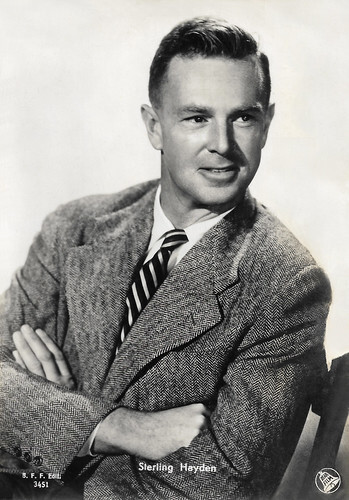
Italian postcard by B.F.F. Edit., no. 3451. Photo: Dear Film.
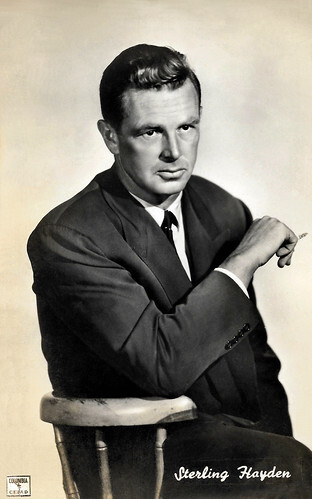
Belgian postcard by Bromofoto, Bruxelles. Photo: Columbia CEIAD.
Sources: Wikipedia (Dutch and English) and .

British postcard in the Picturegoer Series, London, no. W 52. Photo: Paramount.

British postcard in the Picturegoer Series, London, no. D. 75. Photo: Paramount.
The Beautiful Blond Viking God
Sterling Hayden was born Sterling Reylea Walter in Upper Montclair, New Jersey in 1916. He was the son of George Walter and Frances Simonson. In 1925, when he was only nine years old, his father died. His stepfather James Hayden adopted him, and his name was changed to Sterling Walter Hayden. In his youth, he lived in New Hampshire, Massachusetts, Pennsylvania, Washington D.C. and Maine, among other places.
Hayden was certainly not of wealthy stock, yet he attended Wassookeag School, a preparatory school in Dexter, Maine, until he was seventeen. After that, he fled to the sea. He worked aboard ships, first as a cabin boy on a schooner, later as a fisherman on the waters around Newfoundland and even as a fireman. In 1935, he received his first command. He sailed the world several times and became a ship captain at 22.
The young captain stood out greatly for his qualities as a captain and his height (1m96), blond hair and muscular body. Hayden wanted to own his boat and decided to moonlight in the modelling world, prompting Paramount Pictures to call and offer a screen test. Hayden did a test in New York with Jeanne Cagney, James Cagney 's sister. In 1940, he signed a seven-year contract with Paramount beginning at $250 a week. The studio began advertising him as 'The Most Beautiful Man in the Movies!' and 'The Beautiful Blond Viking God'.
In his first film, Virginia (Edward H. Griffith, 1941), he starred with one of Paramount's best-known actresses, Madeleine Carroll . The two fell in love and married. After a second film with Carroll, Bahama Passage (Edward H. Griffith, 1941), Hayden left Hollywood to work as an undercover agent for William J. Donovan's Office of Strategic Services - the predecessor of the CIA -, where he remained when it changed to the Office of Strategic Services (OSS). When the United States was attacked at Pearl Harbor during World War II, Hayden joined the Marines under the pseudonym John Hamilton to obscure his Hollywood past.
He went to Europe, where he smuggled weapons and supplies through the German line to the Yugoslav resistance and parachuted over fascist Croatia. Hayden befriended Yugoslav communists and received a Silver Star for his achievements and a commendation from Josip Broz Tito. After returning to the US, he continued acting. He was cast as one of several brothers in an aviation film, Blaze of Noon (John Farrow, 1947). The studio suspended him when he turned down a role in The Sainted Sisters. In 1946, he joined the Communist Party for six months. When McCarthyism took hold of America in 1951, Hayden admitted before the House Committee on Un-American Activities that he had ties to Communism. He also named some names. Hayden always regretted his actions, which he saw as a betrayal, and later wrote in his autobiography that he greatly despised himself around that time.

British postcard in the Celebrity Autograph Series, no. 189. Photo: Republic. Sterling Hayden in Timberjack (Joseph Kane, 1955).

Italian postcard by B.F.F. Edit., no. 3331. Photo: ENIC. Sterling Hayden in Battle Taxi (Herbert L. Strock, 1955).
The Wanderer
After several unsuccessful roles for Paramount, Hayden went freelance, although he did not enjoy the film world. He invested the money he earned in ship projects. During the 1950s, he starred in several Westerns and Film Noirs. Hayden had a starring role in John Huston 's Noir classic The Asphalt Jungle (1950), for which he received excellent reviews. He had a support role in a big studio picture, Prince Valiant (Henry Hathway, 1954), playing Sir Gawain.
That year, he acted in Nicholas Ray's Western Johnny Guitar (1954), starring Joan Crawford . It was a box office hit and became a cult favourite. However, his career was marked by mediocre roles, periods of absence when he was sailing, and bad films. There were some exceptions, though, such as Stanley Kubrick's The Killing (1956). He was also offered the role of knife-throwing Britt in The Magnificent Seven (John Sturges, 1960), but he was unavailable.
Sterling Hayden was reunited with Kubrick in Dr. Strangelove or: How I Learned to Stop Worrying and Love the Bomb (Stanley Kubrick, 1964). For his role as General Jack D. Ripper, he was nominated for a BAFTA Award. However, he never lost his passion for sailing. Hayden periodically left the acting world to focus on his passion. In 1969, he bought a residential barge in the Netherlands, which he later moved to Paris and lived in. In 1972, he played the role of the corrupt cop McCluskey in the award-winning gangster film The Godfather (Francis Ford Coppola, 1972), which marked his return to the big screen. He played alcoholic novelist Roger Wade in Robert Altman's The Long Goodbye (1973), and elderly peasant Leo Dalcò in Bernardo Bertolucci's 1900 (1976).
Hayden was cast as the sailor Quint in Steven Spielberg's Jaws (1975), but he had to decline due to tax problems. With a distinctive 'rapid-fire baritone' voice and a height of 1m96, he had a commanding screen presence in leading and supporting roles. He returned to Hollywood for King of the Gypsies (Frank Pierson, 1978), Winter Kills (William Richert, 1979), The Outsider (Tony Luraschi, 1980), 9 to 5 (Colin Higgins, 1980), the Canadian comedy Gas (Les Rose, 1981), Venom (Piers Haggard, 1981) and TV Mini Series The Blue and the Gray (Andrew V. McLaglen, 1982).
Sterling Hayden also wrote two books. In 1963, his autobiography, 'Wanderer', was released, in which he wrote about his sea voyages and his regrets about cooperating with the House Committee on Un-American Activities. In 1976, the novel 'Voyage' was published. In 1983, he appeared in a documentary on his life, Leuchtturm des Chaos/Lighthouse of Chaos (Manfred Blank, Wolf-Eckart Bühler, 1983). Sterling Hayden has been married to three women and was the father of six children. His first marriage was to British actress Madeleine Carroll . It lasted four years (1942-1946). His second marriage, to Betty Ann de Noon (1947-1953, 1954-1955, 1956-1958), was turbulent: they divorced and remarried twice before breaking up for good in August 1958. What followed was a nasty battle for custody of their four children, Christian, Dana, Gretchen and Matthew. Hayden made headlines in 1959 when he ignored a court ruling on custody and took his four children on his schooner The Wanderer on a trip to Tahiti. His last marriage, to Catherine Devine McConnell (1960-1986), lasted until he died. With her, Hayden had two children, Andrew and David. In 1986, Sterling Hayden died of prostate cancer. He was seventy years old.

Italian postcard by B.F.F. Edit., no. 3451. Photo: Dear Film.

Belgian postcard by Bromofoto, Bruxelles. Photo: Columbia CEIAD.
Sources: Wikipedia (Dutch and English) and .
Published on May 03, 2024 22:00
May 2, 2024
Fernandel
Actor and singer Fernandel (1903–1971) was for more than forty years France's top comedy star. He was perhaps best-loved for his portrayal of Don Camillo. His horse-like teeth and shy manner became his trademark.
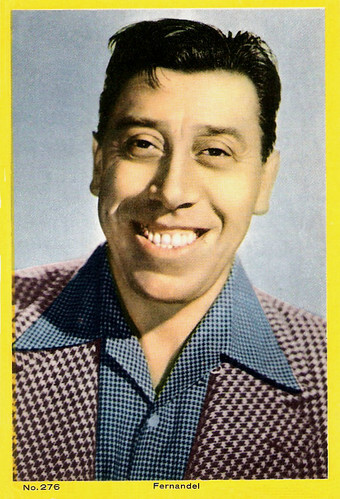
Mexican Collectors card, no. 276.
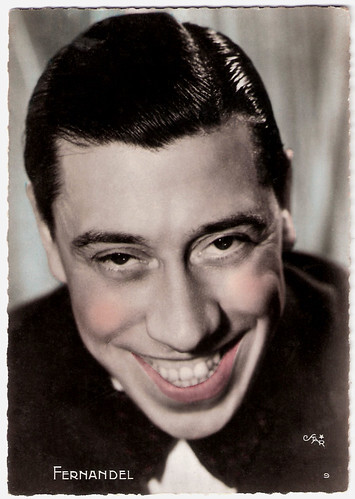
French postcard by Editions O.P., Paris, no. 9. Photo: Star.
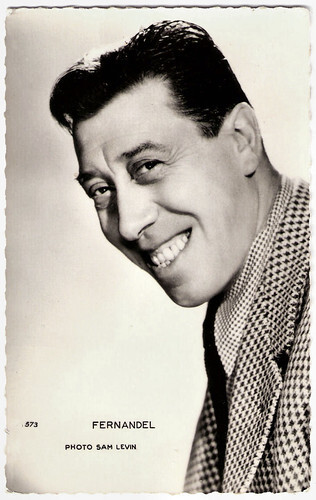
French postcard by Editions P.I., no. 573. Photo: Sam Lévin.
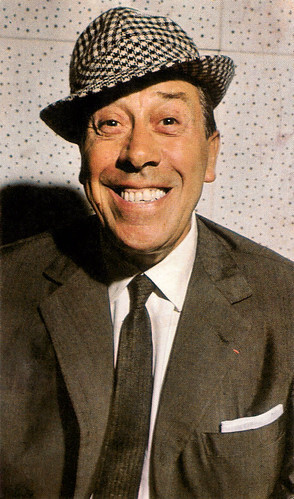
French postcard by PSG, offered by Corvisart, Epinal no. 443. Photo: Nisak.
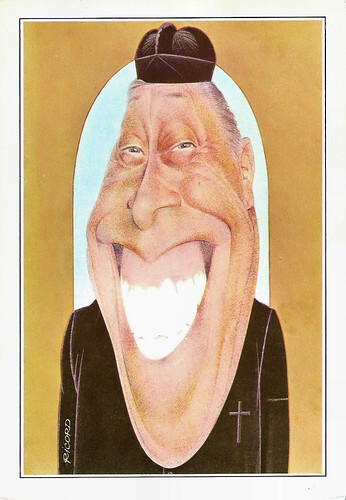
French postcard in the Les Grandes Gueules Series by Dervish International Publications, Paris, no. 105. Illustration: Ricord.
Popular, common, likeable and with a concealed grain of drama
Fernandel was born as Fernand Joseph Désiré Contandin in Marseille, France, as the son of a music-hall entertainer. His brother Fransined would become an actor too.
Fernandel began performing while still a child. In his teens, he supported himself in a variety of jobs while gaining experience as an amateur comedian and singer. In 1922 he turned professional, soon becoming popular in vaudeville, operettas, and music-hall revues. He married with Henriette Manse in 1925.
His film debut was in Le blanc et le noir/White and Black (Robert Florey, Marc Allégret, 1930) at the side of Raimu . Marc Allégret was also the director of his first successful film La meilleure Bobonne (Marc Allégret, Claude Heymann, 1930). Very popular was his serious role in the screen adaptation of Guy de Maupassant's Le Rosier de Madame Husson/The Virgin Man (Bernard-Deschamps, 1932).
Writer/director Marcel Pagnol used his immense talent and great sensitivity in a series of films: as a half-witted in Angèle (1934), Regain/Harvest (1937), Le Schpountz/Heartbeat (1938), La Fille du puisatier/The Well-Digger's Daughter (1940), and later as a scrupulously honest schoolteacher in Topaze (1951).
Fernandel became a typical actor of the comedy genre: popular, common, likeable and with a concealed grain of drama. For more than four decades and in nearly 150 films he was France's most popular comedy star.
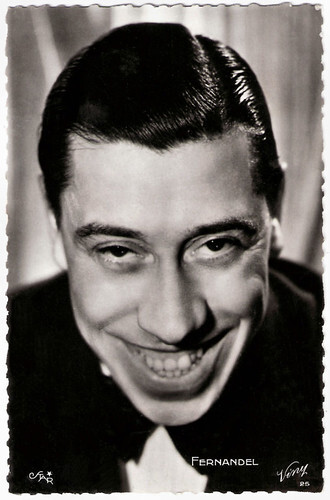
French postcard by Viny, no. 25. Photo: Star.
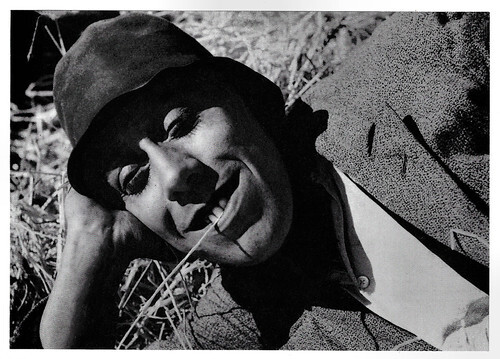
Swiss postcard by News Productions, Baulmes, no. 56505. Photo: Cinémathèque Suisse. Fernandel in Angèle (Marcel Pagnol, 1934).
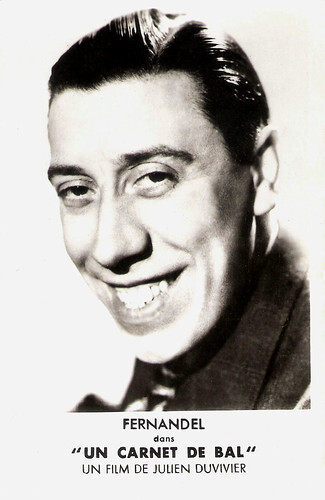
French postcard by Edition Chantal, Paris. Photo: publicity still for Un Carnet de Bal/Dance Program (Julien Duvivier, 1937).
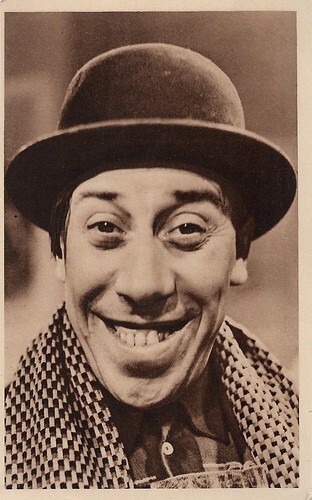
French postcard. Photo: Les Films Marcel Pagnol. Fernandel in Regain (Marcel Pagnol, 1937).
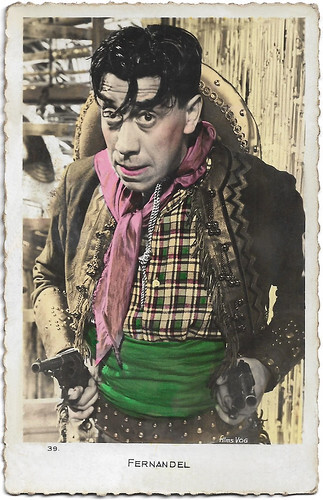
French postcard, no. 39. Photo: Les films Vog. Fernandel in Ernest le rebelle (Christian-Jaque, 1938). The story evolves in South America.
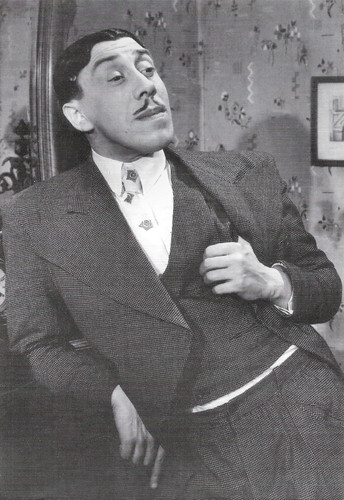
French postcard by DR MPC (Marcel Pagnol Com), no. 7. Photo: Roger Corbeau. Fernandel in Le Schpountz/Heartbeat (Marcel Pagnol, 1938).
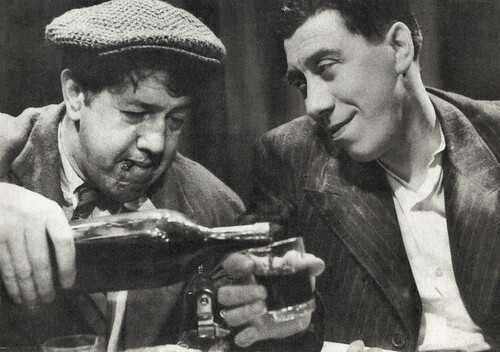
French postcard in the Collection Cinéma by Editions Le Malibran, Paris / Nancy, no. CF 51. Michel Simon and Fernandel in Fric-Frac/Break-In (Maurice Lehmann, Claude Autant-Lara (uncredited), 1939).
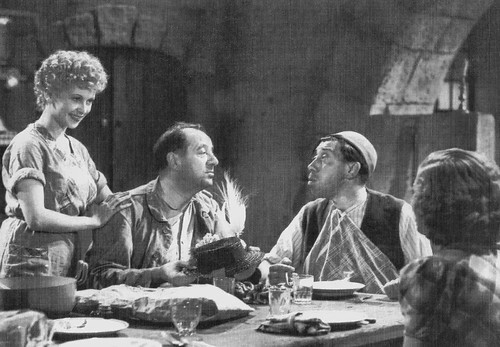
French postcard in the Raimu series by MPC (Marcel Pagnol Com), no. 46. Raimu , Fernandel and Josette Day in La fille du Puisatier (Marcel Pagnol, 1940), written by Marcel Pagnol.
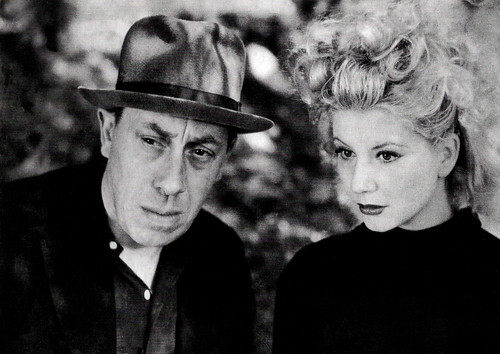
French postcard by MPC (Marcel Pagnol Com), no. 39. Photo: Henri Moiroud. Fernandel and Jacqueline Pagnol in Nais (Raymond Leboursier, Marcel Pagnol, 1945).
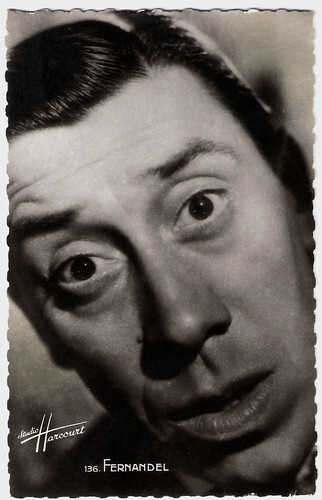
French postcard by S.E.R.P., Paris, no. 136. Photo: Studio Harcourt.
Don Camillo
Fernandel was perhaps best loved for his portrayal of Don Camillo, the humorously indomitable priest of a little Italian parish at war with the village's communist mayor, Peppone (played by Gino Cervi ) in the popular film series of the 1950s.
Director Julien Duvivier first brought the books by Giovanni Guareschi to life in Le Petit monde de Don Camillo/The Little World of Don Camillo (1951) and Le Retour de Don Camillo/The Return of Don Camillo (1953). With other directors, Fernandel made La Grande bagarre de Don Camillo/Don Camillo's Last Round (Carmine Gallone, 1955), Don Camillo Monseigneur/Don Camillo: Monsignor (Carmine Gallone, 1961), and Don Camillo en Russie/Don Camillo in Moscow (Luigi Comencini, 1965).
Among his other successes were L'auberge rouge/The Red Inn (Claude Autant-Lara, 1951), Ali Baba et les quarante voleurs/Ali Baba and the Forty Thieves (Jacques Becker, 1954) and La Vache et le Prisonnier/The Cow and I (Henri Verneuil, 1959). He also appeared in Italian and American films. His first Hollywood motion picture was Around the World in Eighty Days (Michael Anderson, 1956) in which he played David Niven 's coachman. His popular performance in that film led to starring with Bob Hope and Anita Ekberg in the comedy Paris Holiday (Gerd Oswald, 1958).
In addition to acting, Fernandel also directed or co-produced several of his own films. In 1970 Fernandel started with the shooting of the sixth Don Camillo film, Don Camillo et les contestastaires/Don Camillo and the Youth of Today, directed by Christian-Jaque. After a few weeks, he had to stop because of poor health.
Shortly afterwards Fernandel died from lung cancer. He is buried in the Cimetière de Passy, Paris, France. Fernandel and his wife Henriette had three children, including actor Franck Fernandel and actress Josette Contandin.
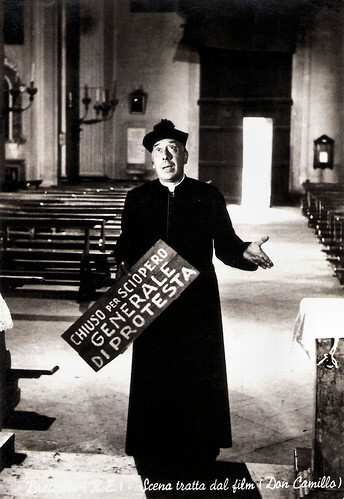
Italian postcard by Ediz. Mussetti-Zanuichelli-Righi-Mingori, Brescello. Photo: Civirani, Roma. Fernandel in Don Camillo/Le petit monde de Don Camillo/The Little World of Don Camillo (Julien Duvivier, 1952).
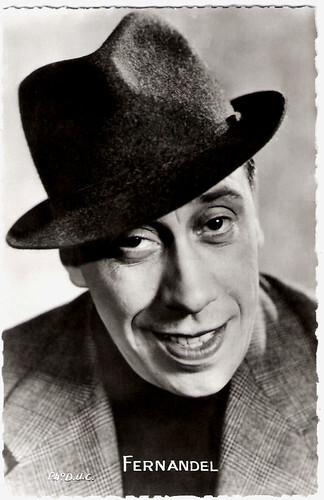
French postcard by Editions Chantal, Rueil. Photo: D.U.C.
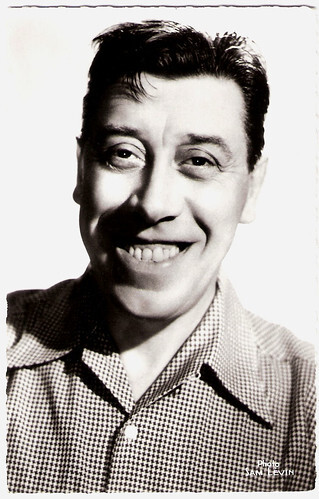
French postcard by Editions du Globe, no. 304. Photo: Sam Lévin.
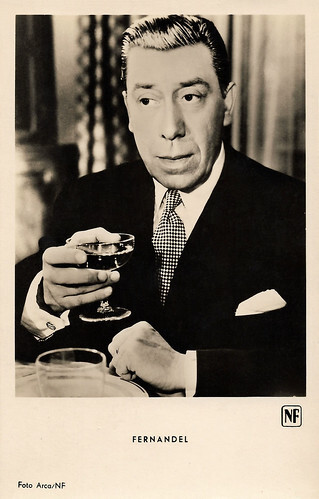
West German postcard by Kunst und Bild, Berlin, no. A 872. Photo: Arca / NF. Fernandel in Le fruit défendu/Forbidden Fruit (Henri Verneuil, 1952).
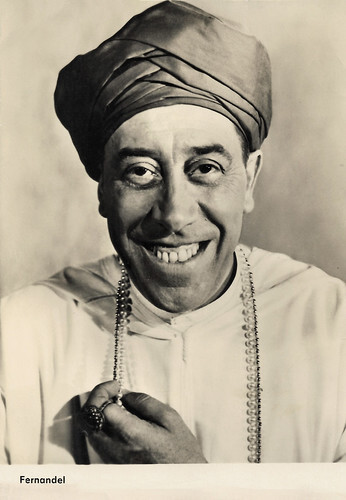
East German postcard by VEB Progress Film-Vertrieb, Berlin, no. 2383, 1965. Fernandel in Ali Baba et les 40 voleurs/Ali Baba and the Forty Thieves (Jacques Becker, 1954).
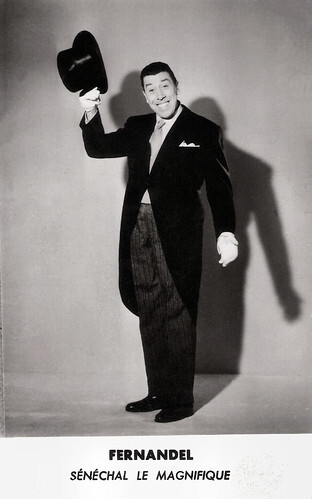
French card. Fernandel in Sénéchal le magnifique/Sénéchal the Magnificent (Jean Boyer, 1957).
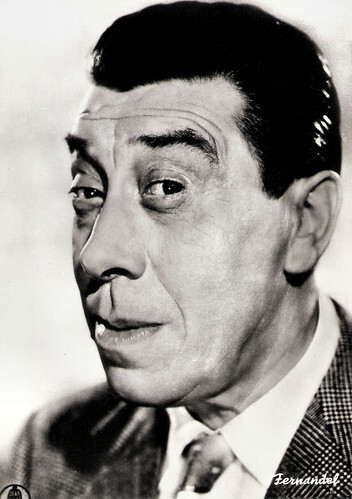
Italian postcard by Bromofoto, Milano, no. 1390. Photo: Dear Film. Fernandel in Paris Holiday (Gerd Oswald, 1958).
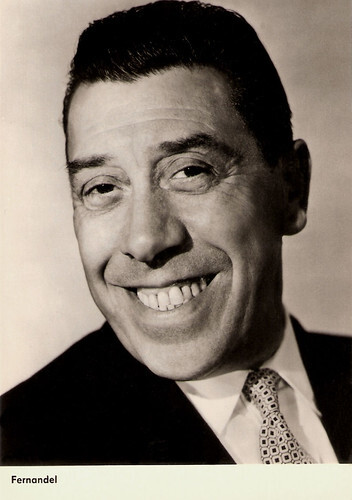
East-German postcard by VEB Progress Film-Vertrieb, Berlin, no. 2919, 1967. Retail price: 0,20 DM. Photo: Unifrancefilm.
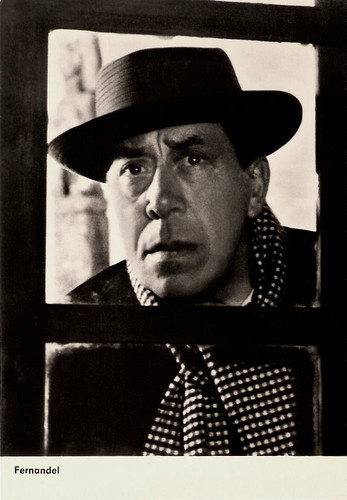
German postcard by Progress, no. 1.973, 1964. Retail price: 0,20 DM. Photo: publicity still for Le diable et les dix commandements/The Devil and the Ten Commandments (Julien Duvivier, 1962).
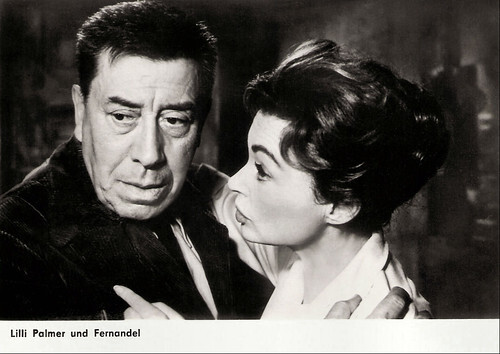
German postcard by Progress, no. 2994, 1967. Retail price: 0,20 DM. Photo: publicity still for Le voyage du père/Father's Trip (Denys de La Patellière, 1966) with Lilli Palmer .
Sources: (IMDb), Wikipedia, AllMovie, and .

Mexican Collectors card, no. 276.

French postcard by Editions O.P., Paris, no. 9. Photo: Star.

French postcard by Editions P.I., no. 573. Photo: Sam Lévin.

French postcard by PSG, offered by Corvisart, Epinal no. 443. Photo: Nisak.

French postcard in the Les Grandes Gueules Series by Dervish International Publications, Paris, no. 105. Illustration: Ricord.
Popular, common, likeable and with a concealed grain of drama
Fernandel was born as Fernand Joseph Désiré Contandin in Marseille, France, as the son of a music-hall entertainer. His brother Fransined would become an actor too.
Fernandel began performing while still a child. In his teens, he supported himself in a variety of jobs while gaining experience as an amateur comedian and singer. In 1922 he turned professional, soon becoming popular in vaudeville, operettas, and music-hall revues. He married with Henriette Manse in 1925.
His film debut was in Le blanc et le noir/White and Black (Robert Florey, Marc Allégret, 1930) at the side of Raimu . Marc Allégret was also the director of his first successful film La meilleure Bobonne (Marc Allégret, Claude Heymann, 1930). Very popular was his serious role in the screen adaptation of Guy de Maupassant's Le Rosier de Madame Husson/The Virgin Man (Bernard-Deschamps, 1932).
Writer/director Marcel Pagnol used his immense talent and great sensitivity in a series of films: as a half-witted in Angèle (1934), Regain/Harvest (1937), Le Schpountz/Heartbeat (1938), La Fille du puisatier/The Well-Digger's Daughter (1940), and later as a scrupulously honest schoolteacher in Topaze (1951).
Fernandel became a typical actor of the comedy genre: popular, common, likeable and with a concealed grain of drama. For more than four decades and in nearly 150 films he was France's most popular comedy star.

French postcard by Viny, no. 25. Photo: Star.

Swiss postcard by News Productions, Baulmes, no. 56505. Photo: Cinémathèque Suisse. Fernandel in Angèle (Marcel Pagnol, 1934).

French postcard by Edition Chantal, Paris. Photo: publicity still for Un Carnet de Bal/Dance Program (Julien Duvivier, 1937).

French postcard. Photo: Les Films Marcel Pagnol. Fernandel in Regain (Marcel Pagnol, 1937).

French postcard, no. 39. Photo: Les films Vog. Fernandel in Ernest le rebelle (Christian-Jaque, 1938). The story evolves in South America.

French postcard by DR MPC (Marcel Pagnol Com), no. 7. Photo: Roger Corbeau. Fernandel in Le Schpountz/Heartbeat (Marcel Pagnol, 1938).

French postcard in the Collection Cinéma by Editions Le Malibran, Paris / Nancy, no. CF 51. Michel Simon and Fernandel in Fric-Frac/Break-In (Maurice Lehmann, Claude Autant-Lara (uncredited), 1939).

French postcard in the Raimu series by MPC (Marcel Pagnol Com), no. 46. Raimu , Fernandel and Josette Day in La fille du Puisatier (Marcel Pagnol, 1940), written by Marcel Pagnol.

French postcard by MPC (Marcel Pagnol Com), no. 39. Photo: Henri Moiroud. Fernandel and Jacqueline Pagnol in Nais (Raymond Leboursier, Marcel Pagnol, 1945).

French postcard by S.E.R.P., Paris, no. 136. Photo: Studio Harcourt.
Don Camillo
Fernandel was perhaps best loved for his portrayal of Don Camillo, the humorously indomitable priest of a little Italian parish at war with the village's communist mayor, Peppone (played by Gino Cervi ) in the popular film series of the 1950s.
Director Julien Duvivier first brought the books by Giovanni Guareschi to life in Le Petit monde de Don Camillo/The Little World of Don Camillo (1951) and Le Retour de Don Camillo/The Return of Don Camillo (1953). With other directors, Fernandel made La Grande bagarre de Don Camillo/Don Camillo's Last Round (Carmine Gallone, 1955), Don Camillo Monseigneur/Don Camillo: Monsignor (Carmine Gallone, 1961), and Don Camillo en Russie/Don Camillo in Moscow (Luigi Comencini, 1965).
Among his other successes were L'auberge rouge/The Red Inn (Claude Autant-Lara, 1951), Ali Baba et les quarante voleurs/Ali Baba and the Forty Thieves (Jacques Becker, 1954) and La Vache et le Prisonnier/The Cow and I (Henri Verneuil, 1959). He also appeared in Italian and American films. His first Hollywood motion picture was Around the World in Eighty Days (Michael Anderson, 1956) in which he played David Niven 's coachman. His popular performance in that film led to starring with Bob Hope and Anita Ekberg in the comedy Paris Holiday (Gerd Oswald, 1958).
In addition to acting, Fernandel also directed or co-produced several of his own films. In 1970 Fernandel started with the shooting of the sixth Don Camillo film, Don Camillo et les contestastaires/Don Camillo and the Youth of Today, directed by Christian-Jaque. After a few weeks, he had to stop because of poor health.
Shortly afterwards Fernandel died from lung cancer. He is buried in the Cimetière de Passy, Paris, France. Fernandel and his wife Henriette had three children, including actor Franck Fernandel and actress Josette Contandin.

Italian postcard by Ediz. Mussetti-Zanuichelli-Righi-Mingori, Brescello. Photo: Civirani, Roma. Fernandel in Don Camillo/Le petit monde de Don Camillo/The Little World of Don Camillo (Julien Duvivier, 1952).

French postcard by Editions Chantal, Rueil. Photo: D.U.C.

French postcard by Editions du Globe, no. 304. Photo: Sam Lévin.

West German postcard by Kunst und Bild, Berlin, no. A 872. Photo: Arca / NF. Fernandel in Le fruit défendu/Forbidden Fruit (Henri Verneuil, 1952).

East German postcard by VEB Progress Film-Vertrieb, Berlin, no. 2383, 1965. Fernandel in Ali Baba et les 40 voleurs/Ali Baba and the Forty Thieves (Jacques Becker, 1954).

French card. Fernandel in Sénéchal le magnifique/Sénéchal the Magnificent (Jean Boyer, 1957).

Italian postcard by Bromofoto, Milano, no. 1390. Photo: Dear Film. Fernandel in Paris Holiday (Gerd Oswald, 1958).

East-German postcard by VEB Progress Film-Vertrieb, Berlin, no. 2919, 1967. Retail price: 0,20 DM. Photo: Unifrancefilm.

German postcard by Progress, no. 1.973, 1964. Retail price: 0,20 DM. Photo: publicity still for Le diable et les dix commandements/The Devil and the Ten Commandments (Julien Duvivier, 1962).

German postcard by Progress, no. 2994, 1967. Retail price: 0,20 DM. Photo: publicity still for Le voyage du père/Father's Trip (Denys de La Patellière, 1966) with Lilli Palmer .
Sources: (IMDb), Wikipedia, AllMovie, and .
Published on May 02, 2024 22:00
May 1, 2024
Die Sporck'schen Jäger (1927)
The German silent film Die Sporck'schen Jäger/The Sporck Battalion (Holger Madsen, 1927), produced by Carl Boese Film, was based on the novel 'Das Bataillon Sporck' (1912) by Richard Skowronnek. The film had an all-star cast including Albert Steinrück, Fritz Alberti, Otto Gebühr, Grete Mosheim, Walter Rilla and Elizza La Porta.
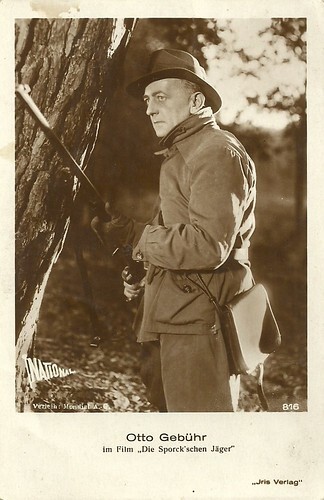
Austrian postcard by Iris Verlag, no. 816. Photo: National / Verleih Mondial A.G. Otto Gebühr in Die Sporck'schen Jäger/The Sporck Battalion (Holger-Madsen, 1927).
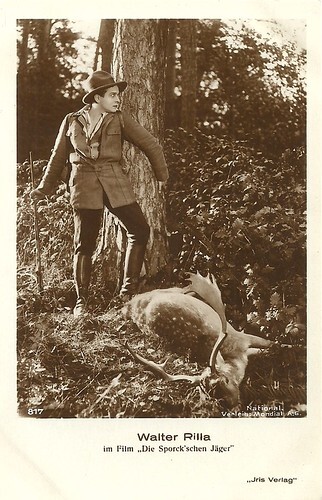
Austrian postcard by Iris Verlag, no. 817. Photo: National / Verleih Mondial A.G. Walter Rilla in Die Sporck'schen Jäger/The Sporck Battalion (Holger-Madsen, 1927).
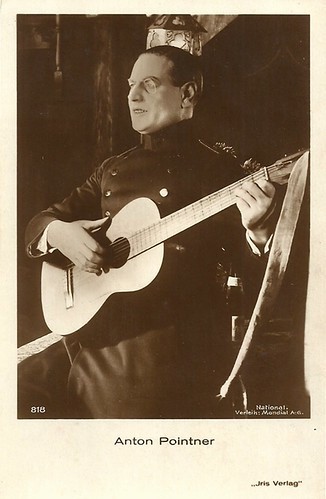
Austrian postcard by Iris Verlag, no. 818. Photo: National / Verleih Mondial A.G. Anton Pointner in Die Sporck'schen Jäger/The Sporck Battalion (Holger-Madsen, 1927).
Foresters, poachers and a bataillon
Lenzburg, East Prussia, circa 1900. The chief forester Rüdiger (Albert Steinrück) is annoyed by a poacher who only takes the antlers and lets the meat go to waste. He suspects the perpetrator to be someone from the Sporck battalion, stationed nearby.
This leads to a break with his friend, Lieutenant Colonel Brinkmann (Fritz Alberti), who commands the battalion. On her return from Berlin, the forester's daughter Elisabeth ( Grete Mosheim ) meets in the train Oberleutnant Erich Fiedler ( Anton Pointner ), who will command the battalion.
But Fiedler's announced visit to the forester's house is postponed because Rüdiger no longer receives officers. Elisabeth's fatherly admirer Captain Rabenheiner ( Otto Gebühr ) identifies Lieutenant von Naugaard ( Walter Rilla ) as the poacher. He is having an affair with Mike ( Elizza la Porta ), the daughter of widow Retelsdorf.
Against his will, Rüdiger gets a 'helper' from the ranks of the authorities. But when von Naugaard rejects Mike, her mother informs Rüdiger who the poacher is. Rüdiger confronts him, and von Naugaard has to challenge him to a duel, but the former succumbs to a heart attack, after which von Naugaard shoots himself.Elisabeth prefers Rabenheiner to the smooth Fiedler.
In 1934 Rolf Randolf filmed the novel 'Das Bataillon Sporck' (1912) again. Fritz Alberti returned as Brinkmann. The cast included Theodor Loos as Rüdiger, Werner Schott as Rabenhainer, and Fritz Genschow as von Naugaard.
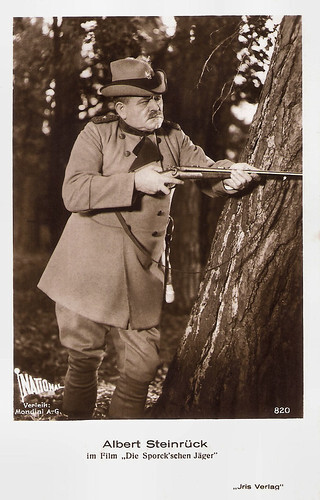
Austrian postcard by Iris Verlag, no. 820. Photo: National / Verleih Mondial A.G. Albert Steinrück in Die Sporck'schen Jäger/The Sporck Battalion (Holger-Madsen, 1927).
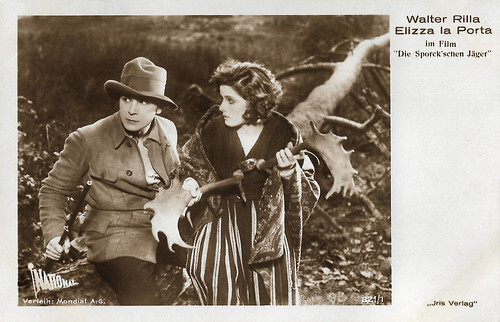
Austrian postcard by Iris Verlag, no. 821/1 Photo: National / Verleih Mondial A.G. Walter Rilla and Elizza La Porta in Die Sporck'schen Jäger/The Sporck Battalion (Holger-Madsen, 1927).
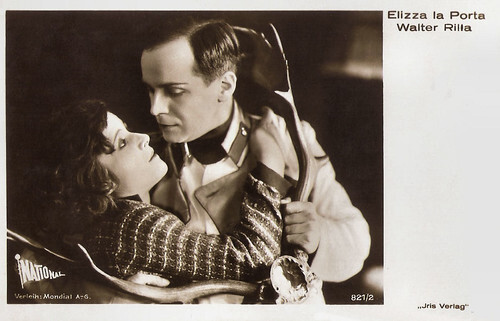
Austrian postcard by Iris Verlag, no. 821/2. Photo: National / Verleih Mondial A.G. Elizza La Porta and Walter Rilla in Die Sporck'schen Jäger/The Sporck Battalion (Holger-Madsen, 1927).
Sources: Filmportal, Wikipedia (German) and IMDb.

Austrian postcard by Iris Verlag, no. 816. Photo: National / Verleih Mondial A.G. Otto Gebühr in Die Sporck'schen Jäger/The Sporck Battalion (Holger-Madsen, 1927).

Austrian postcard by Iris Verlag, no. 817. Photo: National / Verleih Mondial A.G. Walter Rilla in Die Sporck'schen Jäger/The Sporck Battalion (Holger-Madsen, 1927).

Austrian postcard by Iris Verlag, no. 818. Photo: National / Verleih Mondial A.G. Anton Pointner in Die Sporck'schen Jäger/The Sporck Battalion (Holger-Madsen, 1927).
Foresters, poachers and a bataillon
Lenzburg, East Prussia, circa 1900. The chief forester Rüdiger (Albert Steinrück) is annoyed by a poacher who only takes the antlers and lets the meat go to waste. He suspects the perpetrator to be someone from the Sporck battalion, stationed nearby.
This leads to a break with his friend, Lieutenant Colonel Brinkmann (Fritz Alberti), who commands the battalion. On her return from Berlin, the forester's daughter Elisabeth ( Grete Mosheim ) meets in the train Oberleutnant Erich Fiedler ( Anton Pointner ), who will command the battalion.
But Fiedler's announced visit to the forester's house is postponed because Rüdiger no longer receives officers. Elisabeth's fatherly admirer Captain Rabenheiner ( Otto Gebühr ) identifies Lieutenant von Naugaard ( Walter Rilla ) as the poacher. He is having an affair with Mike ( Elizza la Porta ), the daughter of widow Retelsdorf.
Against his will, Rüdiger gets a 'helper' from the ranks of the authorities. But when von Naugaard rejects Mike, her mother informs Rüdiger who the poacher is. Rüdiger confronts him, and von Naugaard has to challenge him to a duel, but the former succumbs to a heart attack, after which von Naugaard shoots himself.Elisabeth prefers Rabenheiner to the smooth Fiedler.
In 1934 Rolf Randolf filmed the novel 'Das Bataillon Sporck' (1912) again. Fritz Alberti returned as Brinkmann. The cast included Theodor Loos as Rüdiger, Werner Schott as Rabenhainer, and Fritz Genschow as von Naugaard.

Austrian postcard by Iris Verlag, no. 820. Photo: National / Verleih Mondial A.G. Albert Steinrück in Die Sporck'schen Jäger/The Sporck Battalion (Holger-Madsen, 1927).

Austrian postcard by Iris Verlag, no. 821/1 Photo: National / Verleih Mondial A.G. Walter Rilla and Elizza La Porta in Die Sporck'schen Jäger/The Sporck Battalion (Holger-Madsen, 1927).

Austrian postcard by Iris Verlag, no. 821/2. Photo: National / Verleih Mondial A.G. Elizza La Porta and Walter Rilla in Die Sporck'schen Jäger/The Sporck Battalion (Holger-Madsen, 1927).
Sources: Filmportal, Wikipedia (German) and IMDb.
Published on May 01, 2024 22:00
April 30, 2024
Betty Darmand
Little is known about actress Betty Darmand, of whom in the 1900s countless German, French and Austrian postcards were made by Rotophot and other brands.
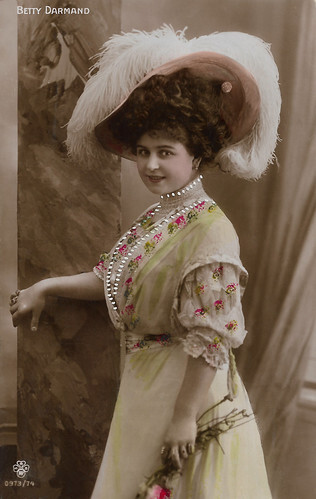
German postcard by SBW (?), no. 0973/74.
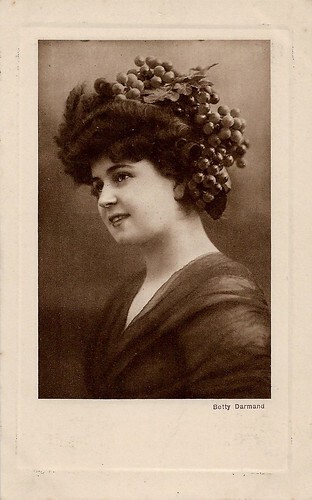
Austrian postcard in the Wiener Rotophot series, no. 2319.
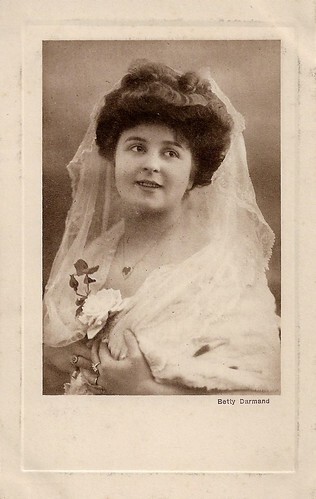
Austrian postcard in the Wiener Rotophot series, no. 2319.
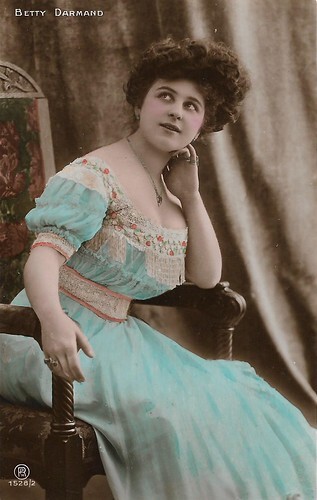
German postcard by Rotophot, no. 1528/2.
The new star of the Berliner Oper
Who was Betty Darmand?
An October 1907 issue of the German periodical, Die Woche, identified Darmand as a French beauty on the German stage.
In the same month, the Prager Tageblatt identified her as the new star of the Berliner Oper. Among her stage successes was the Operetta 'Die Dollarprinzessin' (1907-1908) by Leo Fall, with Joseph Josephi and Edith Whitney.
She was listed in the Berlin Metropol-Theater section of the 1908 Neuer Theater Almanach as 'Mlle. Darmand'.
Renowned German photographers such as Georg Gerlach portrayed her and Ernst Schneider photographed her in 1911 for the magazine Das Weib.
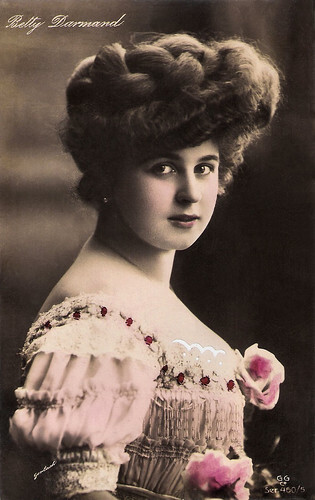
German postcard by GG Co., Serie 450/5. Photo: Georg Gerlach.
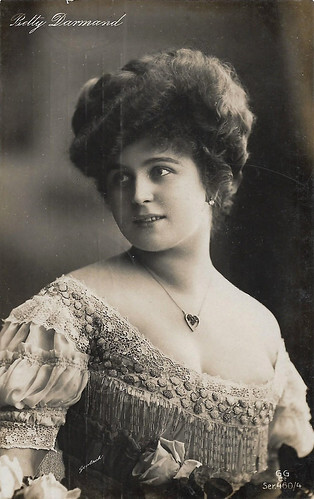
German postcard by GG Co., Serie 460/4. Photo: Georg Gerlach.
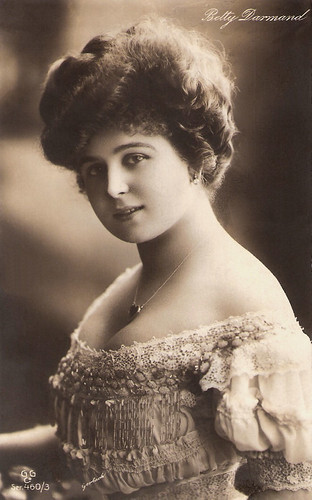
German postcard by GG Co., Serie 460/3. Photo: Georg Gerlach.
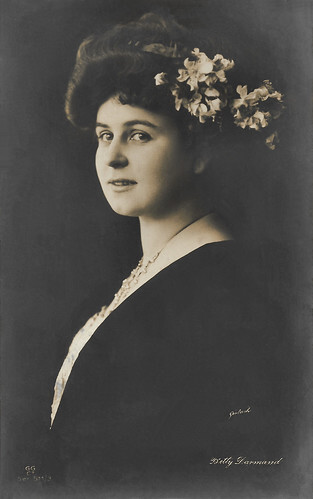
German postcard by GG Co., Serie 511/3. Photo: Georg Gerlach.
The films of a Fashion Queen
According to IMDb , Betty Darmand only acted in three films, in the 1910s.
She first appeared in two productions by Paul Davidson for PAGU/ Union: Börse und Adel/Stock Market and Nobility (Felix Basch, 1916), opposite Harry Liedtke and Hermann Vallentin , and the film comedy Die Laune einer Modekönigin/The Whims of a Fashion Queen (Felix Basch, 1916), opposite Harry Liedtke , Albert Paulig and Manny Ziener.
Both films were well published in the German and Austrian press. Referencing her film career, a 1917 issue of Die Fackel describes Die Launen einer Modekönigin as a film that allows viewers to admire the well-known model, Betty Darmand.
In the Austrian press, Darmand herself was presented as a fashion queen.
In her last film, Hotel Esplanade (Karin Swanström, 1919), Betty Darmand impersonated the role of the Marquise de Barrini opposite Paul Bildt and Grit Hegesa .
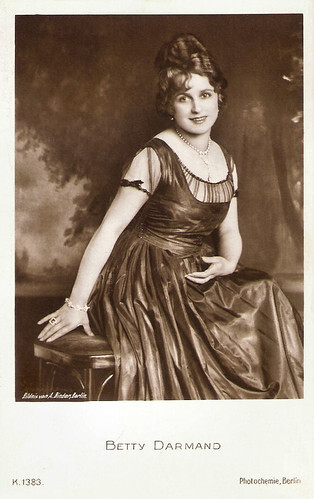
German postcard by Photochemie, Berlin, no. K. 1383. Photo: Alex Binder, Berlin.
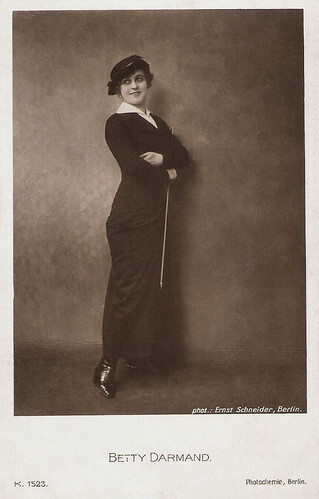
German postcard by Photochemie, Berlin, no. K. 1523. Photo: Ernst Schneider, Berlin.
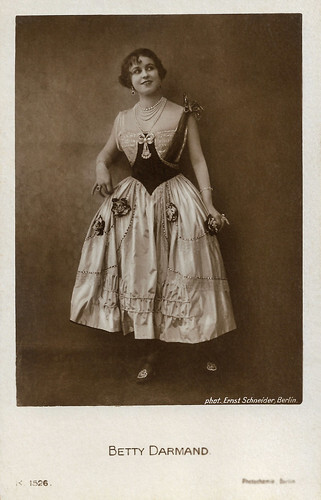
German postcard by Photochemie, Berlin, no. K. 1526. Photo: Ernst Schneider, Berlin.
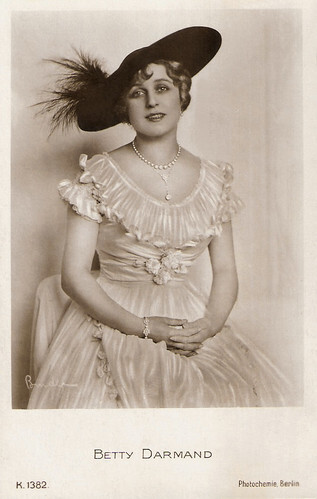
German postcard by Photochemie, Berlin, no. K. 1382. Photo: Alex Binder, Berlin.
Sources: Thomas Staedeli (Cyranos) and .

German postcard by SBW (?), no. 0973/74.

Austrian postcard in the Wiener Rotophot series, no. 2319.

Austrian postcard in the Wiener Rotophot series, no. 2319.

German postcard by Rotophot, no. 1528/2.
The new star of the Berliner Oper
Who was Betty Darmand?
An October 1907 issue of the German periodical, Die Woche, identified Darmand as a French beauty on the German stage.
In the same month, the Prager Tageblatt identified her as the new star of the Berliner Oper. Among her stage successes was the Operetta 'Die Dollarprinzessin' (1907-1908) by Leo Fall, with Joseph Josephi and Edith Whitney.
She was listed in the Berlin Metropol-Theater section of the 1908 Neuer Theater Almanach as 'Mlle. Darmand'.
Renowned German photographers such as Georg Gerlach portrayed her and Ernst Schneider photographed her in 1911 for the magazine Das Weib.

German postcard by GG Co., Serie 450/5. Photo: Georg Gerlach.

German postcard by GG Co., Serie 460/4. Photo: Georg Gerlach.

German postcard by GG Co., Serie 460/3. Photo: Georg Gerlach.

German postcard by GG Co., Serie 511/3. Photo: Georg Gerlach.
The films of a Fashion Queen
According to IMDb , Betty Darmand only acted in three films, in the 1910s.
She first appeared in two productions by Paul Davidson for PAGU/ Union: Börse und Adel/Stock Market and Nobility (Felix Basch, 1916), opposite Harry Liedtke and Hermann Vallentin , and the film comedy Die Laune einer Modekönigin/The Whims of a Fashion Queen (Felix Basch, 1916), opposite Harry Liedtke , Albert Paulig and Manny Ziener.
Both films were well published in the German and Austrian press. Referencing her film career, a 1917 issue of Die Fackel describes Die Launen einer Modekönigin as a film that allows viewers to admire the well-known model, Betty Darmand.
In the Austrian press, Darmand herself was presented as a fashion queen.
In her last film, Hotel Esplanade (Karin Swanström, 1919), Betty Darmand impersonated the role of the Marquise de Barrini opposite Paul Bildt and Grit Hegesa .

German postcard by Photochemie, Berlin, no. K. 1383. Photo: Alex Binder, Berlin.

German postcard by Photochemie, Berlin, no. K. 1523. Photo: Ernst Schneider, Berlin.

German postcard by Photochemie, Berlin, no. K. 1526. Photo: Ernst Schneider, Berlin.

German postcard by Photochemie, Berlin, no. K. 1382. Photo: Alex Binder, Berlin.
Sources: Thomas Staedeli (Cyranos) and .
Published on April 30, 2024 22:00
April 29, 2024
Kurt Russell
American actor Kurt Russell (1951) started his career as a child star in numerous TV series and Walt Disney Company films. He was nominated for an Emmy Award for his title role in John Carpenter's television film Elvis (1979) and five years later for a Golden Globe for his supporting role in Silkwood (1983). Russell worked repeatedly with directors John Carpenter and Quentin Tarantino.
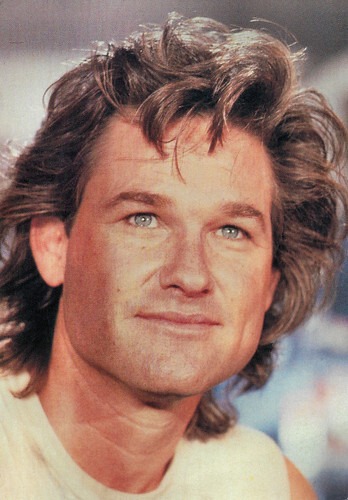
Big Italian collector card, ca. 1990.
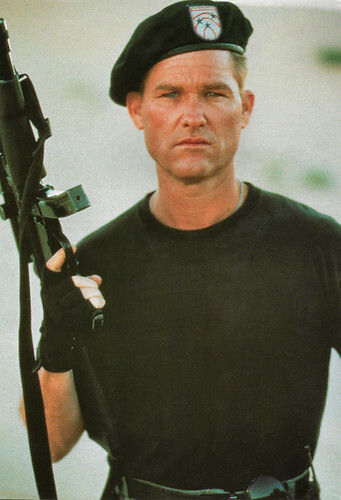
French postcard by Sonis, no. C. 517. Photo: Studio Canal + (U.S.). Kurt Russell in Stargate (Roland Emmerich, 1994).
Kicking Elvis Presley in the leg
Kurt Vogel Russell was born in Springfield, Massachusetts, in 1951. He is the son of actor Bing Russell, known for his role as the sheriff on the TV Western Bonanza, and dancer Louise Julia (née Crone). His family relocated to California when he was a child, and Russell grew up in Thousand Oaks. Kurt appeared in the television series Sugarfoot as early as 1957. His film debut was the Elvis Presley vehicle It Happened at the World's Fair (Norman Taurog, 1961). He played a boy who kicked a pilot ( Elvis Presley ) in the leg.
At twelve, he made his first major appearance as Jaimie McPheeters in the Western TV series The Travels of Jaimie McPheeters (1963-1964). The series also featured Dan O'Herlihy, Charles Bronson and the then very young Osmonds. In 1966, Russell signed a ten-year contract with Walt Disney Productions and acted in the films Follow Me, Boys! (Norman Tokar, 1966) with Fred MacMurray , The Computer Wore Tennis Shoes (Robert Butler, 1969), Now You See Him, Now You Don't (Robert Butler, 1972) and The Strongest Man in the World (Vincent McEveety, 1975).
Russell became the studio's top star of the 1970s. In 1970, he also recorded an unsuccessful pop album, 'Kurt Russell', for Capitol. After his experiences as a child star, he played baseball during the first half of the 1970s. He played second base on a minor league team for the California Angels (now the Los Angeles Angels of Anaheim). After suffering a rotator cuff injury to one shoulder, he was forced to retire from the sport in 1973. He then turned his full attention back to acting.
In 1979, he played Elvis Presley in the television movie Elvis (John Carpenter, 1979) in which his then-wife Season Hubley played Priscilla. This would transition Russell's Hollywood career after years as a child actor. It also led to a series of collaborations with director John Carpenter. AllMovie : "His next role as a sleazy used car salesman in Robert Zemeckis' hilariously caustic Used Cars (1980) allowed him to counter his wholesome, all-American nice guy image, and prove that he was an actor of untapped range. Director Carpenter recognized this and cast Russell as ruthless mercenary Snake Plissken in his brooding sci-fi/action film Escape From New York (1981). The role would prove to be one of legendary status and one that would cement Russell as a cult hero for generations to come. Carpenter also cast Russell as a scientist stranded in the Antarctic in his chilling 1982 remake of The Thing. Realizing that his characters were larger than life, Russell typically played them with a subtle tongue-in-cheek quality."
Another success was Silkwood (Mike Nichols, 1983) with Meryl Streep and Cher . The success of that film helped him break into a more mainstream arena. In 1983, Kurt Russell fell in love with Goldie Hawn, while shooting Swing Shift (Jonathan Demme, 1984). The film flopped but the two have been a couple ever since. Their next joint film, the hilarious comedy Overboard (Garry Marshall, 1987) was a success. Other memorable films are the comedy Rocket Man (Roger Spottiswoode, 1986) starring Robin Williams , Big Trouble in Little China (John Carpenter, 1986) and Winter People (Ted Kotcheff, 1989).
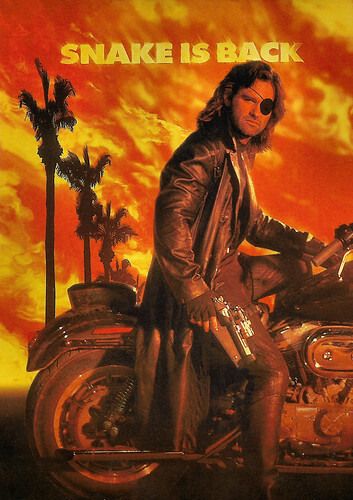
British freecard by Boomerang. Image: United International Pictures / Paramount. Kurt Russell in Escape from L.A. (John Carpenter, 1996). Caption: Snake is back. Plan your escape.
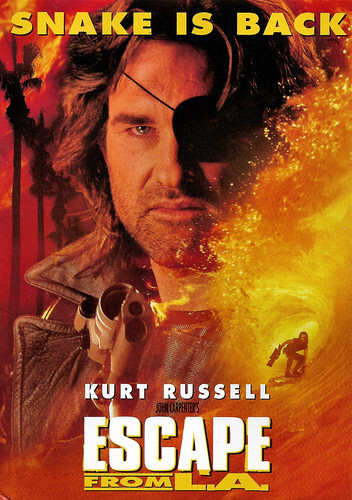
American freecard by Max Racks. Image: Paramount Pictures. Kurt Russell in Escape from L.A. (John Carpenter, 1996). Caption: Snake is back. Plan your escape.
Stuntman Mike and Mr. Nobody
At the end of the 1980s, Kurt Russell's career seemed to slip until he got the lead opposite Sylvester Stallone in Tango & Cash (Andrej Konchalovskiy, Albert Magnoli, 1989), as Patrick Swayze refused the role. Russell's role in Backdraft (Ron Howard, 1991) marked his comeback, while Dennis Quaid was the first choice for that role.
He was the star of the Science Fiction film Stargate (Roland Emmerich, 1994) about a stargate that allows one to travel from one planet to another and back again. The blockbuster eventually formed the basis for the Stargate series in 1997 with Richard Dean Anderson in Russell's role.
Russell returned as Snake Plisskin in Escape from L.A. (John Carpenter, 1996). He also co-wrote the screenplay with John Carpenter and Debra Hill. Another highlight in his career is Grindhouse (Robert Rodriguez, Quentin Tarantino, 2007), split into two stories; Death Proof and Planet Terror. Tarantino directed Death Proof in which Russell starred as the psychopathic Stuntman Mike who kills young women with his stunt car.
He co-starred as Mr. Nobody in the action hit Furious 7/Fast & Furious 7 (James Wan, 2015), starring Vin Diesel and Paul Walker. He reunited with Quentin Tarantino for the Western The Hateful Eight (Quentin Tarantino, 2015) starring Samuel Jackson and Jennifer Jason Leigh, and the action film Once Upon a Time in Hollywood (Quentin Tarantino, 2019) with Leonardo DiCaprio , Brad Pitt and Margot Robbie. Russell returned as Mr. Nobody in The Fate of the Furious/Fast & Furious 8 (G. Gary Gray, 2017), another smash hit, and F9/F9: The Fast Saga (Justin Lin, 2021).
In 2017, Russell and Hawn received a star on the Hollywood Walk of Fame in a joint ceremony. That year, he was seen in the Marvel epic Guardians of the Galaxy Vol. 2 (James Gunn 2017) in the role of Ego. The following year, he played Santa Claus in the Christmas film The Christmas Chronicles (Clay Kaytis, 2018). Kurt Russell and Goldie Hawn live on a ranch near Aspen. Russell has a son from his first marriage to Season Hubley, Boston Russell, and a son with Hawn, Wyatt Russell. He also has a stepdaughter and a stepson, Kate Hudson and Oliver Hudson, the daughter and son of Hawn and Bill Hudson.
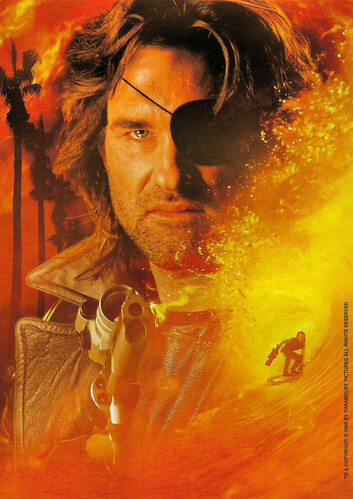
Dutch freecard by Boomerang Studycards, Haarlem. Image: Paramount Pictures. Kurt Russell in Escape from L.A. (John Carpenter, 1996).
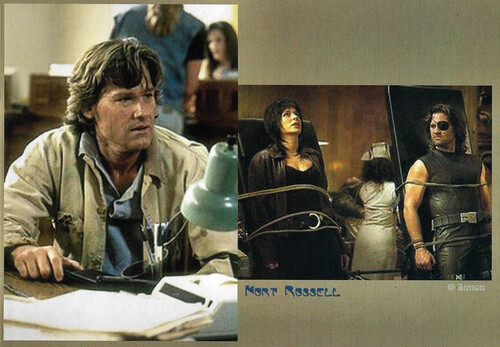
German postcard in the Actors and Actresses series by Bookking International, Stuttgart, no. 733-748. Photos: Paramount Pictures. Kurt Russell and Valeria Golina in Escape from L.A. (John Carpenter, 1996).
Sources: (IMDb), AllMovie, Wikipedia (Dutch, German and English) and .

Big Italian collector card, ca. 1990.

French postcard by Sonis, no. C. 517. Photo: Studio Canal + (U.S.). Kurt Russell in Stargate (Roland Emmerich, 1994).
Kicking Elvis Presley in the leg
Kurt Vogel Russell was born in Springfield, Massachusetts, in 1951. He is the son of actor Bing Russell, known for his role as the sheriff on the TV Western Bonanza, and dancer Louise Julia (née Crone). His family relocated to California when he was a child, and Russell grew up in Thousand Oaks. Kurt appeared in the television series Sugarfoot as early as 1957. His film debut was the Elvis Presley vehicle It Happened at the World's Fair (Norman Taurog, 1961). He played a boy who kicked a pilot ( Elvis Presley ) in the leg.
At twelve, he made his first major appearance as Jaimie McPheeters in the Western TV series The Travels of Jaimie McPheeters (1963-1964). The series also featured Dan O'Herlihy, Charles Bronson and the then very young Osmonds. In 1966, Russell signed a ten-year contract with Walt Disney Productions and acted in the films Follow Me, Boys! (Norman Tokar, 1966) with Fred MacMurray , The Computer Wore Tennis Shoes (Robert Butler, 1969), Now You See Him, Now You Don't (Robert Butler, 1972) and The Strongest Man in the World (Vincent McEveety, 1975).
Russell became the studio's top star of the 1970s. In 1970, he also recorded an unsuccessful pop album, 'Kurt Russell', for Capitol. After his experiences as a child star, he played baseball during the first half of the 1970s. He played second base on a minor league team for the California Angels (now the Los Angeles Angels of Anaheim). After suffering a rotator cuff injury to one shoulder, he was forced to retire from the sport in 1973. He then turned his full attention back to acting.
In 1979, he played Elvis Presley in the television movie Elvis (John Carpenter, 1979) in which his then-wife Season Hubley played Priscilla. This would transition Russell's Hollywood career after years as a child actor. It also led to a series of collaborations with director John Carpenter. AllMovie : "His next role as a sleazy used car salesman in Robert Zemeckis' hilariously caustic Used Cars (1980) allowed him to counter his wholesome, all-American nice guy image, and prove that he was an actor of untapped range. Director Carpenter recognized this and cast Russell as ruthless mercenary Snake Plissken in his brooding sci-fi/action film Escape From New York (1981). The role would prove to be one of legendary status and one that would cement Russell as a cult hero for generations to come. Carpenter also cast Russell as a scientist stranded in the Antarctic in his chilling 1982 remake of The Thing. Realizing that his characters were larger than life, Russell typically played them with a subtle tongue-in-cheek quality."
Another success was Silkwood (Mike Nichols, 1983) with Meryl Streep and Cher . The success of that film helped him break into a more mainstream arena. In 1983, Kurt Russell fell in love with Goldie Hawn, while shooting Swing Shift (Jonathan Demme, 1984). The film flopped but the two have been a couple ever since. Their next joint film, the hilarious comedy Overboard (Garry Marshall, 1987) was a success. Other memorable films are the comedy Rocket Man (Roger Spottiswoode, 1986) starring Robin Williams , Big Trouble in Little China (John Carpenter, 1986) and Winter People (Ted Kotcheff, 1989).

British freecard by Boomerang. Image: United International Pictures / Paramount. Kurt Russell in Escape from L.A. (John Carpenter, 1996). Caption: Snake is back. Plan your escape.

American freecard by Max Racks. Image: Paramount Pictures. Kurt Russell in Escape from L.A. (John Carpenter, 1996). Caption: Snake is back. Plan your escape.
Stuntman Mike and Mr. Nobody
At the end of the 1980s, Kurt Russell's career seemed to slip until he got the lead opposite Sylvester Stallone in Tango & Cash (Andrej Konchalovskiy, Albert Magnoli, 1989), as Patrick Swayze refused the role. Russell's role in Backdraft (Ron Howard, 1991) marked his comeback, while Dennis Quaid was the first choice for that role.
He was the star of the Science Fiction film Stargate (Roland Emmerich, 1994) about a stargate that allows one to travel from one planet to another and back again. The blockbuster eventually formed the basis for the Stargate series in 1997 with Richard Dean Anderson in Russell's role.
Russell returned as Snake Plisskin in Escape from L.A. (John Carpenter, 1996). He also co-wrote the screenplay with John Carpenter and Debra Hill. Another highlight in his career is Grindhouse (Robert Rodriguez, Quentin Tarantino, 2007), split into two stories; Death Proof and Planet Terror. Tarantino directed Death Proof in which Russell starred as the psychopathic Stuntman Mike who kills young women with his stunt car.
He co-starred as Mr. Nobody in the action hit Furious 7/Fast & Furious 7 (James Wan, 2015), starring Vin Diesel and Paul Walker. He reunited with Quentin Tarantino for the Western The Hateful Eight (Quentin Tarantino, 2015) starring Samuel Jackson and Jennifer Jason Leigh, and the action film Once Upon a Time in Hollywood (Quentin Tarantino, 2019) with Leonardo DiCaprio , Brad Pitt and Margot Robbie. Russell returned as Mr. Nobody in The Fate of the Furious/Fast & Furious 8 (G. Gary Gray, 2017), another smash hit, and F9/F9: The Fast Saga (Justin Lin, 2021).
In 2017, Russell and Hawn received a star on the Hollywood Walk of Fame in a joint ceremony. That year, he was seen in the Marvel epic Guardians of the Galaxy Vol. 2 (James Gunn 2017) in the role of Ego. The following year, he played Santa Claus in the Christmas film The Christmas Chronicles (Clay Kaytis, 2018). Kurt Russell and Goldie Hawn live on a ranch near Aspen. Russell has a son from his first marriage to Season Hubley, Boston Russell, and a son with Hawn, Wyatt Russell. He also has a stepdaughter and a stepson, Kate Hudson and Oliver Hudson, the daughter and son of Hawn and Bill Hudson.

Dutch freecard by Boomerang Studycards, Haarlem. Image: Paramount Pictures. Kurt Russell in Escape from L.A. (John Carpenter, 1996).

German postcard in the Actors and Actresses series by Bookking International, Stuttgart, no. 733-748. Photos: Paramount Pictures. Kurt Russell and Valeria Golina in Escape from L.A. (John Carpenter, 1996).
Sources: (IMDb), AllMovie, Wikipedia (Dutch, German and English) and .
Published on April 29, 2024 22:00
April 28, 2024
La Collectionneuse: Photo by Vicente Ibanez
Gifted Spanish photographer Vicente Ibanez (1930-2010) opened his studio in the beginning of the 1950s. It was situated at Gran Via, in Madrid. He came from a dynasty of photographers. Ibanez shot many portraits of film and stage stars and other artists and was often referred to as 'El fotografo de las estrellas' (The stars’ photographer). He closed his studio in 1996.
Mercedes Alonso
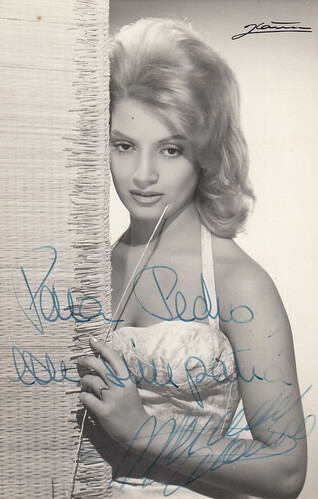
Spanish autographed postcard. Photo: Vicente Ibanez.
Mercedes Alonso (1940) made her screen debut in 1958 and was at the peak of her film career at the beginning of the 1960s. Her most famous role was as a sexy university student in Margarita se llama mi amor (1961), which was a big success at the time. Her other films include El cerra de los locos (1960) and Aqui estan las vicetiples (1961). A few years later, she was featured in several European Westerns such as La tumba del pistolero (1964) and Solo contro tutti/El hijo de Jesse James (1965). Later, she was much more active on stage and on television. For example, she notably played a young and independent artist with whom a lonely and stern septuagenarian falls in love in the episode Adios felicidad (1973) from the popular series Cronicas de un pueblo and had a recurrent role in the well-received Farmacia de guardia from 1991 to 1995.
Margarita Andrey
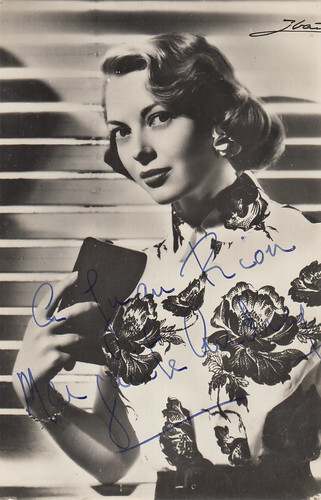
Spanish autographed postcard. Photo: Vicente Ibanez.
Margarita Andrey (1926) was the daughter of a Spain-based Swiss official. In the mid-1940s, she became a movie star and her films include La mantilla de Beatriz (1946), El verdugo (1948), Mi hijo Veronica (1950), El cerco del diablo (1952), La ciudad de los suenos (1954), Historias de la radio (1955), Nunca es demasiado tarde (1956), … In the mid-1950s, she retired following her marriage.
Maria (Maruja) Asquerino
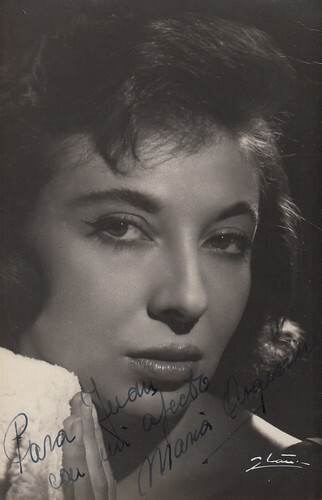
Spanish postcard. Photo: Vicente Ibanez.
Maria (Maruja) Asquerino (1925-2013) had a long and fruitful movie career which began in the 1940s and ended in 2009. She was featured in, for example, Conflicto inesperado (1948), Don Juan de Serralonga (1949), Surcos (1951), Como la tierra (1954), La vida en un bloc (1956), A tiro limpio (1964), De cuerpo presente (1967), Goya, historia de una soledad (1971), Pecado mortal (1977), El gran secreto (1980), Mambru se fue a la guerra (1986), El mar y el tiempo (1989), Fuera de juego (1991), Nadie hablara de nosostros cuando hayamos muerto (1995), Tiovivo c. 1950 (2004), … She also was a brilliant stage actress and was especially praised in 1973 for her performance in Antonio Gala’s 'Anillos para una dama'. She acted in other plays which showed her versatility and her talent, such as Euripides’ 'Hippolytus', Lope de Vega’s 'El caballero de Olmedo' and 'La bella marmaridada', Carlo Goldoni’s 'I pettegolezzi delle donne', Anton Chekhov’s 'The Seagull' and 'Uncle Vanya', Paul Claudel’s 'Le soulier de satin', Eugene Ionesco’s 'Le roi se meurt', Eduardo de Filippo’s 'Filomena Marturano', José Maria Rodriguez Mendez’s 'Flor de otono', etc.
Yvonne Bastien a.k.a. Ivonne de Lys
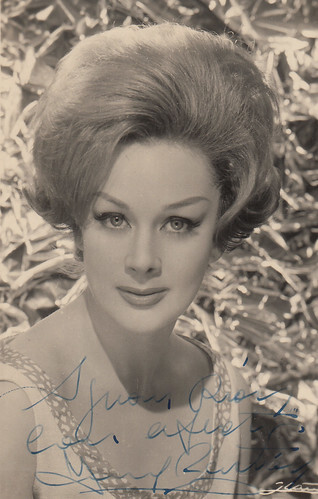
Spanish autographed postcard. Photo: Vicente Ibanez.
Argentinian-born Yvonne Bastien a.k.a. Ivonne de Lys (1933) had a French father and a Spanish mother. From 1945 to 1950, she appeared in several Argentinian films, using at the time the name 'Ivonne de Lys'. She retired following her first marriage in 1952 and, in 1957, remarried with Spanish director Antonio Roman. She settled in Spain and came back to the screen, this time as 'Yvonne Bastien', in 1961. She then starred in several films, mostly directed by her husband, such as La moglie de mi marito/Mi mujer mi gusta mas (1961), El sol en el espejo (1963), Pacto de silencio (1963) and Un tiro por la espalda (1964). Her filmography ended with Antonio Roman’s El meson del gitano (1970), opposite popular singer Peret.
Lina Canalejas
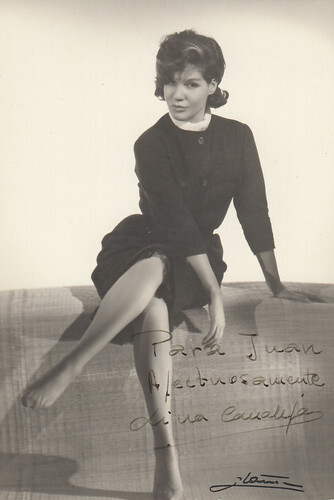
Spanish autographed postcard. Photo: Vicente Ibanez.
After several years of rewarding experience in variety shows, Lina Canalejas (1932-2012) embarked on a brilliant career in theatre from the mid-1950s. She notably got one of her better roles in Jaime Salom’s 'La casa de las chivas'. She also had an interesting filmography. She especially starred in two major works from director Fernando Fernan Gomez, El mundo sigue (1963), which met with censorship problems at the time, and El extrano viaje (1964). She also played a nun called Hermana Vibora (Sister Viper) in Pedro Almodovar’s Entre tenieblas (1983). Her other films include El fenomeno (1956), El secreto de Papa (1959), Mi calle (1960), La prima Angelica (1974), El love feroz (1975), ...
Rocio Durcal
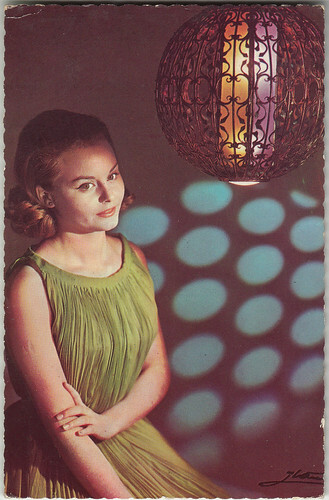
Spanish postcard by Ediciones Tarjefher, no. 221. Photo: Vicente Ibanez.
Rocio Durcal (1944-2006) became a star thanks to her first movie Cancion de juventud (1962), which made the best use of her musical talents. It was followed by other popular musicals such as Rocio de la Mancha (1963), Tengo 17 anos (1964), Mas bonita que ninguna (1965) and Buenos dias, condesita (1967). She played her first dramatic role in Cristina Guzman (1968) and then went back to musicals in Las Leandras (1969) and La novicia rebelde (1972). The dramas Marianela (1972) and Diselo con flores/Dites-le avec des fleurs (1974) were her two first films in which she didn’t sing. In 1977, she played a lesbian in Me siento extrana, a role she regretted to have accepted. She then decided to give up films and to focus on her singing career. She soon specialized in a popular Mexican style of music known as 'ranchera' and became a true icon in that field, selling millions of records.
Ava Gardner
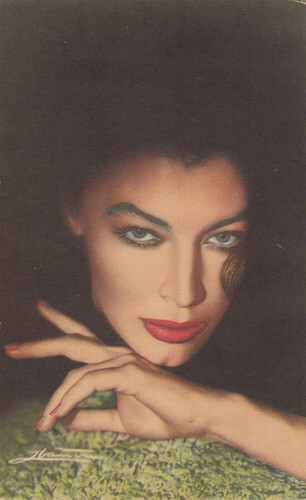
Spanish postcard by Edicolor S.A., Madrid, no. 18. Photo: Vicente Ibanez.
American love goddess Ava Gardner (1922-1990) first came to Spain in 1950 for the filming of Pandora and the Flying Dutchman. She immediately fell in love with that country. In December 1955, she went to live there. In the second half of the 1960s, she somewhat had grown tired of her life in Spain and began to talk about living in London. She settled permanently in England’s capital in 1968.
Katia Loritz
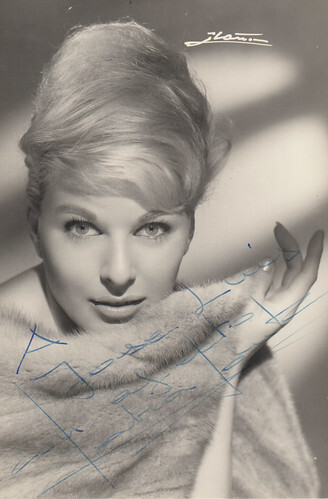
Spanish autographed postcard. Photo: Vicente Ibanez.
Swiss-born Katia Loritz (1932-2015) got her big break opposite Amadeo Nazzari in Manos sucias/La morte ha viaggiato con me (1957). She later starred in Spanish movies such as Las chicas de la Cruz Roja (1958), Mi calle (1960), Atracos a la tres (1962), Trampa mortal (1963), Rueda de sospechosos (1964), … She married in 1966 and, after, El rostro del asasino (1967), she gave up her film career. However, she came back once to the big screen in Pedro Almodovar’s Qué he hecho yo para merecer esto! (1984). In later years, she devoted much time to painting.
Maria Mahor
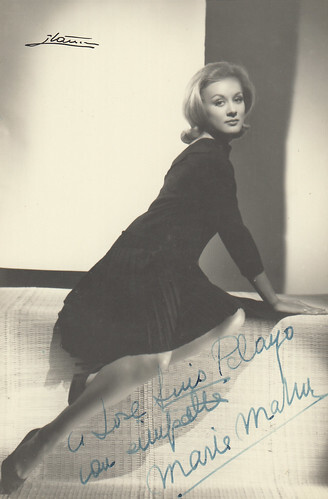
Spanish autographed postcard. Photo: Vicente Ibanez.
Following a contest, Maria Mahor (1940 ? 1941 ?) was chosen by director Pedro Lazaga for the female lead of Roberto el diablo (1957). The young girl made a good impression on audiences and later starred in other films such as El dia de los enamorados (1959), Melocoton en almibar (1960), Rosa de Lima (1962), Bochorno (1963), Jandro (1965), Clarines y campanas (1966), Los hombres las prefieren viudas (1970), Mecanismo interior (1971), Todos los gritos del silencio (1975), ... In addition to her screen career, she also appeared occasionally in theatre plays. In the first half of the 1970s, she was especially praised as Dona Ines in Jose Zorrilla’s 'Don Juan Tenorio'. Her filmography ended in 1975 and she was thereafter more active on stage.
Marisol
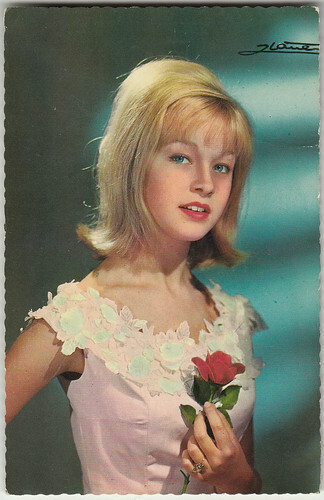
Spanish postcard by Ediciones Tarjefher, no. 121.Photo: Vicente Ibanez.
Marisol (1948) became a hugely popular child star thanks to her first movie Un rayo de luz (1960), followed by, e.g., Tombola (1962) and Marisol rumbo a Rio (1963). In the second half of the 1960s, she matured into a ravishing young lady, without losing the audiences’ favour, and was featured in films such as Las 4 bodas de Marisol (1967) and Carola de dia, Carola de noche (1969). From 1973 on, she turned to dramatic roles and appeared for instance in La corrupcion de Chris Miller (1973), El poder del deseo (1975) and Los dias del pasado (1977). She retired after Caso cerrado (1985).
Maria Martin a.k.a. Mery Martin
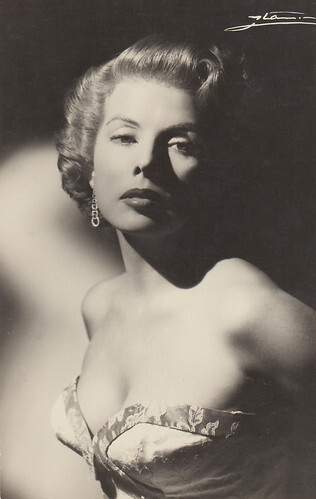
Spanish postcard. Photo: Vicente Ibanez.
Maria Martin (1923-2014) made her screen debut in 1943 and chose to be called Mery Martin. The spelling 'Mery' was uncommon and quite exotic for Spanish audiences. But, in a way, it matched her somewhat Anglo-Saxon blonde looks. She quickly became a star and appeared in Turbante blanco (1944), Culpable! (1945), El angel gris (1947), Cancion mortal (1948), El hombre de mundo (1949), El senorito Octavio (1950), Alba de America (1951), … She also starred in three Italian films: La mano della morta (1949), Capitan Demonio (1950) and Voto di marinaio (1953). But her unusual pseudonym ended up becoming somewhat of a problem. Indeed, on several occasions, she found herself mistaken for American actress Mary Martin. Therefore, from Alta costura (1954) onwards, she decided to become Maria Martin to avoid any more misunderstandings. So, 'Mery' gave way to the much more Spanish-sounding forename 'Maria'. Until the mid-1960s, she still played leading roles in, for example, El ceniciento (1955), Hospital de urgencia (1956), Ya tenemos coche (1958), Parque de Madrid (1959), Cuidado con las personas formales (1962), Crimen (1964), … Later, she was mostly used in supporting parts.
Elisa Montes
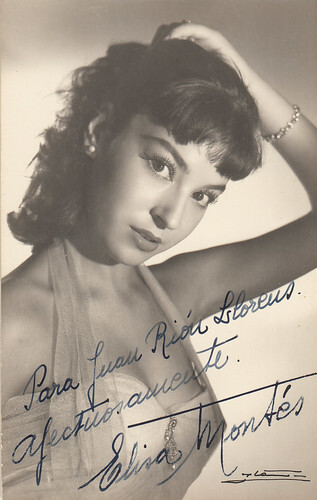
Spanish autographed postcard. Photo: Vicente Ibanez.
The granddaughter of famous composer Manuel Penella, Elisa Montes (1934) made her film debut in 1954 and quickly became popular with audiences. Her films include El mensaje (1954), Las ultimas banderas (1957), El aprendiz de malo (1958), Las dos y media y … veneno (1959), La cuarta ventana (1963), El proscrito del rio Colorado (1965), El muerto hace las maletas/Der Todesrächer von Soho (1972), El chulo (1974), Polvos magicos (1979), … On the big screen, she was mostly active from the mid-1950s to the end of the 1970s. She also worked for television and notably appeared in the cast of Verano azul (1981-1982), one of the most successful series ever produced by Spanish TV. It was not only hugely popular in Spain but also in foreign countries such as Portugal or Bulgaria. On stage, Elisa Montes starred in, for example, José Luis Martin Descalzo’s 'Las prostitutas os precederan en el Reino de los cielos' in the 1980s.
Lina Morgan
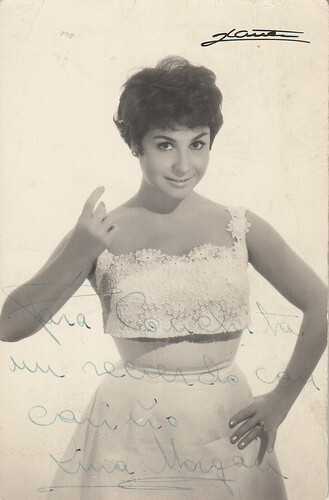
Spanish autographed postcard. Photo: Vicente Ibanez.
Since the beginning of the 1960s, Lina Morgan (1936-2015) was a major figure of the Spanish entertainment world. Her outstanding comedy skills enabled her to stay at the top for several decades. She was a huge stage star and was especially praised for her variety of shows and musicals. Her last one, 'Celeste … no es un color' ran from November 1991 to December 1993. She also performed occasionally in films. For example, from the end of the 1960s to the mid-1970s, she starred in several tailor-made comedies such as Soltera y madre en la vida (1969), La tonta del bote (1970), La graduada (1971), La descarriada (1973), Senora doctor (1974), Las pecados de una chica casi decente (1975) or Un dia con Sergio (1976). Her filmography ended with Hermana, pero qué has hecho? (1995). She too worked to great acclaim for television, notably in the series Hostal Royal Manzanares (1996-1998). From December 2007 to December 2008, she appeared as a guest star in some episodes of Escenas de matrimonio. It was her last acting part.
Conchita Piquer
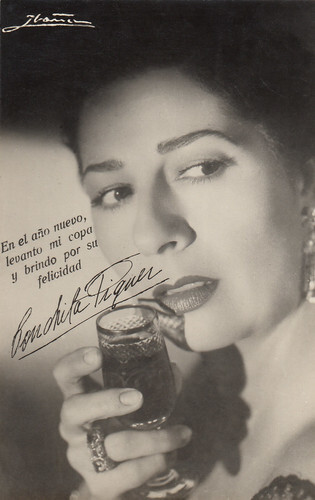
Spanish New Year Greetings postcard. Photo: Vicente Ibanez.
Conchita Piquer (1906-1990) was discovered in Valencia by famous composer Manuel Penella who, at the beginning of the 1920s, took her to the U.S.A. From November 1921 to January 1922, she performed on Broadway in Penella’s musical 'The Wildcat' and was especially praised for the song 'El florero'. She stayed in the U.S. for several years, appearing on stage and making records for Columbia Company. In 1923, she sang and danced in a sound short film produced by inventor Lee De Forest, using the Phonofilm process. In 1926, she came back to Spain, where she soon became one of the most prominent and popular singers of her time. Her most famous songs include 'La maredeuta', 'En tierra extrana', 'Ojos verdes', 'La Parrala', 'Tatuaje', 'Y sin embargo te quiero', … Several years after her American film debut, she starred in two Benito Perojo’s films, El negro que tenia el alma blanca/Le danseur de jazz (1927) and La bodega (1930). She later was featured in Yo canto para ti! (1934), La Dolores (1940), Filigranas (1949) and Me casé con una estrella (1951), which was filmed in Argentina. She made her last stage appearance in 1958.
Text and postcards: Marlène Pilaete.
Mercedes Alonso

Spanish autographed postcard. Photo: Vicente Ibanez.
Mercedes Alonso (1940) made her screen debut in 1958 and was at the peak of her film career at the beginning of the 1960s. Her most famous role was as a sexy university student in Margarita se llama mi amor (1961), which was a big success at the time. Her other films include El cerra de los locos (1960) and Aqui estan las vicetiples (1961). A few years later, she was featured in several European Westerns such as La tumba del pistolero (1964) and Solo contro tutti/El hijo de Jesse James (1965). Later, she was much more active on stage and on television. For example, she notably played a young and independent artist with whom a lonely and stern septuagenarian falls in love in the episode Adios felicidad (1973) from the popular series Cronicas de un pueblo and had a recurrent role in the well-received Farmacia de guardia from 1991 to 1995.
Margarita Andrey

Spanish autographed postcard. Photo: Vicente Ibanez.
Margarita Andrey (1926) was the daughter of a Spain-based Swiss official. In the mid-1940s, she became a movie star and her films include La mantilla de Beatriz (1946), El verdugo (1948), Mi hijo Veronica (1950), El cerco del diablo (1952), La ciudad de los suenos (1954), Historias de la radio (1955), Nunca es demasiado tarde (1956), … In the mid-1950s, she retired following her marriage.
Maria (Maruja) Asquerino

Spanish postcard. Photo: Vicente Ibanez.
Maria (Maruja) Asquerino (1925-2013) had a long and fruitful movie career which began in the 1940s and ended in 2009. She was featured in, for example, Conflicto inesperado (1948), Don Juan de Serralonga (1949), Surcos (1951), Como la tierra (1954), La vida en un bloc (1956), A tiro limpio (1964), De cuerpo presente (1967), Goya, historia de una soledad (1971), Pecado mortal (1977), El gran secreto (1980), Mambru se fue a la guerra (1986), El mar y el tiempo (1989), Fuera de juego (1991), Nadie hablara de nosostros cuando hayamos muerto (1995), Tiovivo c. 1950 (2004), … She also was a brilliant stage actress and was especially praised in 1973 for her performance in Antonio Gala’s 'Anillos para una dama'. She acted in other plays which showed her versatility and her talent, such as Euripides’ 'Hippolytus', Lope de Vega’s 'El caballero de Olmedo' and 'La bella marmaridada', Carlo Goldoni’s 'I pettegolezzi delle donne', Anton Chekhov’s 'The Seagull' and 'Uncle Vanya', Paul Claudel’s 'Le soulier de satin', Eugene Ionesco’s 'Le roi se meurt', Eduardo de Filippo’s 'Filomena Marturano', José Maria Rodriguez Mendez’s 'Flor de otono', etc.
Yvonne Bastien a.k.a. Ivonne de Lys

Spanish autographed postcard. Photo: Vicente Ibanez.
Argentinian-born Yvonne Bastien a.k.a. Ivonne de Lys (1933) had a French father and a Spanish mother. From 1945 to 1950, she appeared in several Argentinian films, using at the time the name 'Ivonne de Lys'. She retired following her first marriage in 1952 and, in 1957, remarried with Spanish director Antonio Roman. She settled in Spain and came back to the screen, this time as 'Yvonne Bastien', in 1961. She then starred in several films, mostly directed by her husband, such as La moglie de mi marito/Mi mujer mi gusta mas (1961), El sol en el espejo (1963), Pacto de silencio (1963) and Un tiro por la espalda (1964). Her filmography ended with Antonio Roman’s El meson del gitano (1970), opposite popular singer Peret.
Lina Canalejas

Spanish autographed postcard. Photo: Vicente Ibanez.
After several years of rewarding experience in variety shows, Lina Canalejas (1932-2012) embarked on a brilliant career in theatre from the mid-1950s. She notably got one of her better roles in Jaime Salom’s 'La casa de las chivas'. She also had an interesting filmography. She especially starred in two major works from director Fernando Fernan Gomez, El mundo sigue (1963), which met with censorship problems at the time, and El extrano viaje (1964). She also played a nun called Hermana Vibora (Sister Viper) in Pedro Almodovar’s Entre tenieblas (1983). Her other films include El fenomeno (1956), El secreto de Papa (1959), Mi calle (1960), La prima Angelica (1974), El love feroz (1975), ...
Rocio Durcal

Spanish postcard by Ediciones Tarjefher, no. 221. Photo: Vicente Ibanez.
Rocio Durcal (1944-2006) became a star thanks to her first movie Cancion de juventud (1962), which made the best use of her musical talents. It was followed by other popular musicals such as Rocio de la Mancha (1963), Tengo 17 anos (1964), Mas bonita que ninguna (1965) and Buenos dias, condesita (1967). She played her first dramatic role in Cristina Guzman (1968) and then went back to musicals in Las Leandras (1969) and La novicia rebelde (1972). The dramas Marianela (1972) and Diselo con flores/Dites-le avec des fleurs (1974) were her two first films in which she didn’t sing. In 1977, she played a lesbian in Me siento extrana, a role she regretted to have accepted. She then decided to give up films and to focus on her singing career. She soon specialized in a popular Mexican style of music known as 'ranchera' and became a true icon in that field, selling millions of records.
Ava Gardner

Spanish postcard by Edicolor S.A., Madrid, no. 18. Photo: Vicente Ibanez.
American love goddess Ava Gardner (1922-1990) first came to Spain in 1950 for the filming of Pandora and the Flying Dutchman. She immediately fell in love with that country. In December 1955, she went to live there. In the second half of the 1960s, she somewhat had grown tired of her life in Spain and began to talk about living in London. She settled permanently in England’s capital in 1968.
Katia Loritz

Spanish autographed postcard. Photo: Vicente Ibanez.
Swiss-born Katia Loritz (1932-2015) got her big break opposite Amadeo Nazzari in Manos sucias/La morte ha viaggiato con me (1957). She later starred in Spanish movies such as Las chicas de la Cruz Roja (1958), Mi calle (1960), Atracos a la tres (1962), Trampa mortal (1963), Rueda de sospechosos (1964), … She married in 1966 and, after, El rostro del asasino (1967), she gave up her film career. However, she came back once to the big screen in Pedro Almodovar’s Qué he hecho yo para merecer esto! (1984). In later years, she devoted much time to painting.
Maria Mahor

Spanish autographed postcard. Photo: Vicente Ibanez.
Following a contest, Maria Mahor (1940 ? 1941 ?) was chosen by director Pedro Lazaga for the female lead of Roberto el diablo (1957). The young girl made a good impression on audiences and later starred in other films such as El dia de los enamorados (1959), Melocoton en almibar (1960), Rosa de Lima (1962), Bochorno (1963), Jandro (1965), Clarines y campanas (1966), Los hombres las prefieren viudas (1970), Mecanismo interior (1971), Todos los gritos del silencio (1975), ... In addition to her screen career, she also appeared occasionally in theatre plays. In the first half of the 1970s, she was especially praised as Dona Ines in Jose Zorrilla’s 'Don Juan Tenorio'. Her filmography ended in 1975 and she was thereafter more active on stage.
Marisol

Spanish postcard by Ediciones Tarjefher, no. 121.Photo: Vicente Ibanez.
Marisol (1948) became a hugely popular child star thanks to her first movie Un rayo de luz (1960), followed by, e.g., Tombola (1962) and Marisol rumbo a Rio (1963). In the second half of the 1960s, she matured into a ravishing young lady, without losing the audiences’ favour, and was featured in films such as Las 4 bodas de Marisol (1967) and Carola de dia, Carola de noche (1969). From 1973 on, she turned to dramatic roles and appeared for instance in La corrupcion de Chris Miller (1973), El poder del deseo (1975) and Los dias del pasado (1977). She retired after Caso cerrado (1985).
Maria Martin a.k.a. Mery Martin

Spanish postcard. Photo: Vicente Ibanez.
Maria Martin (1923-2014) made her screen debut in 1943 and chose to be called Mery Martin. The spelling 'Mery' was uncommon and quite exotic for Spanish audiences. But, in a way, it matched her somewhat Anglo-Saxon blonde looks. She quickly became a star and appeared in Turbante blanco (1944), Culpable! (1945), El angel gris (1947), Cancion mortal (1948), El hombre de mundo (1949), El senorito Octavio (1950), Alba de America (1951), … She also starred in three Italian films: La mano della morta (1949), Capitan Demonio (1950) and Voto di marinaio (1953). But her unusual pseudonym ended up becoming somewhat of a problem. Indeed, on several occasions, she found herself mistaken for American actress Mary Martin. Therefore, from Alta costura (1954) onwards, she decided to become Maria Martin to avoid any more misunderstandings. So, 'Mery' gave way to the much more Spanish-sounding forename 'Maria'. Until the mid-1960s, she still played leading roles in, for example, El ceniciento (1955), Hospital de urgencia (1956), Ya tenemos coche (1958), Parque de Madrid (1959), Cuidado con las personas formales (1962), Crimen (1964), … Later, she was mostly used in supporting parts.
Elisa Montes

Spanish autographed postcard. Photo: Vicente Ibanez.
The granddaughter of famous composer Manuel Penella, Elisa Montes (1934) made her film debut in 1954 and quickly became popular with audiences. Her films include El mensaje (1954), Las ultimas banderas (1957), El aprendiz de malo (1958), Las dos y media y … veneno (1959), La cuarta ventana (1963), El proscrito del rio Colorado (1965), El muerto hace las maletas/Der Todesrächer von Soho (1972), El chulo (1974), Polvos magicos (1979), … On the big screen, she was mostly active from the mid-1950s to the end of the 1970s. She also worked for television and notably appeared in the cast of Verano azul (1981-1982), one of the most successful series ever produced by Spanish TV. It was not only hugely popular in Spain but also in foreign countries such as Portugal or Bulgaria. On stage, Elisa Montes starred in, for example, José Luis Martin Descalzo’s 'Las prostitutas os precederan en el Reino de los cielos' in the 1980s.
Lina Morgan

Spanish autographed postcard. Photo: Vicente Ibanez.
Since the beginning of the 1960s, Lina Morgan (1936-2015) was a major figure of the Spanish entertainment world. Her outstanding comedy skills enabled her to stay at the top for several decades. She was a huge stage star and was especially praised for her variety of shows and musicals. Her last one, 'Celeste … no es un color' ran from November 1991 to December 1993. She also performed occasionally in films. For example, from the end of the 1960s to the mid-1970s, she starred in several tailor-made comedies such as Soltera y madre en la vida (1969), La tonta del bote (1970), La graduada (1971), La descarriada (1973), Senora doctor (1974), Las pecados de una chica casi decente (1975) or Un dia con Sergio (1976). Her filmography ended with Hermana, pero qué has hecho? (1995). She too worked to great acclaim for television, notably in the series Hostal Royal Manzanares (1996-1998). From December 2007 to December 2008, she appeared as a guest star in some episodes of Escenas de matrimonio. It was her last acting part.
Conchita Piquer

Spanish New Year Greetings postcard. Photo: Vicente Ibanez.
Conchita Piquer (1906-1990) was discovered in Valencia by famous composer Manuel Penella who, at the beginning of the 1920s, took her to the U.S.A. From November 1921 to January 1922, she performed on Broadway in Penella’s musical 'The Wildcat' and was especially praised for the song 'El florero'. She stayed in the U.S. for several years, appearing on stage and making records for Columbia Company. In 1923, she sang and danced in a sound short film produced by inventor Lee De Forest, using the Phonofilm process. In 1926, she came back to Spain, where she soon became one of the most prominent and popular singers of her time. Her most famous songs include 'La maredeuta', 'En tierra extrana', 'Ojos verdes', 'La Parrala', 'Tatuaje', 'Y sin embargo te quiero', … Several years after her American film debut, she starred in two Benito Perojo’s films, El negro que tenia el alma blanca/Le danseur de jazz (1927) and La bodega (1930). She later was featured in Yo canto para ti! (1934), La Dolores (1940), Filigranas (1949) and Me casé con una estrella (1951), which was filmed in Argentina. She made her last stage appearance in 1958.
Text and postcards: Marlène Pilaete.
Published on April 28, 2024 22:00
Paul van Yperen's Blog
- Paul van Yperen's profile
- 13 followers
Paul van Yperen isn't a Goodreads Author
(yet),
but they
do have a blog,
so here are some recent posts imported from
their feed.



